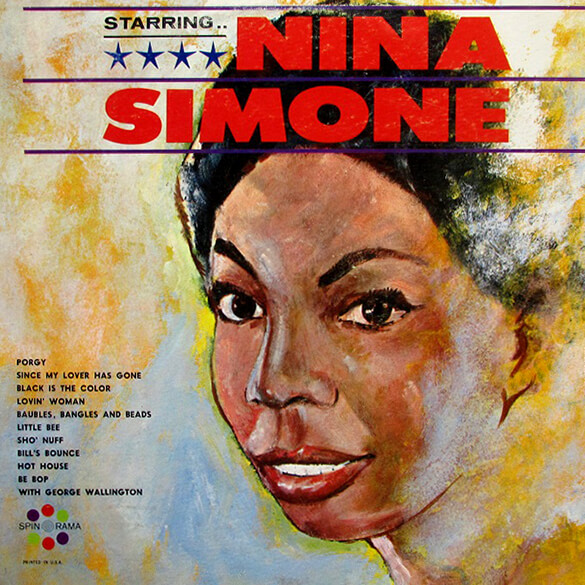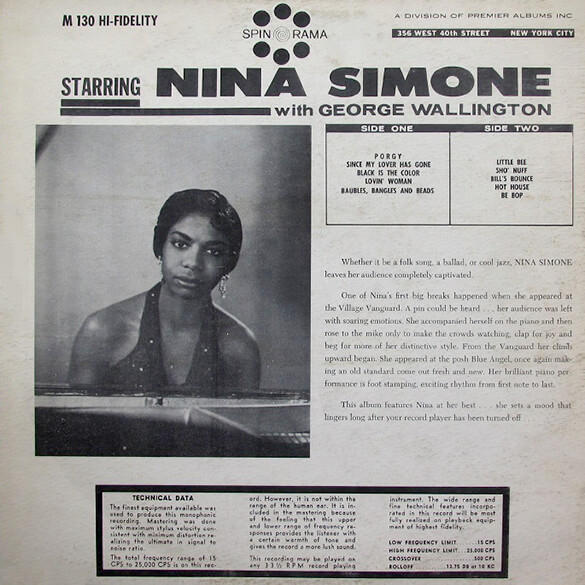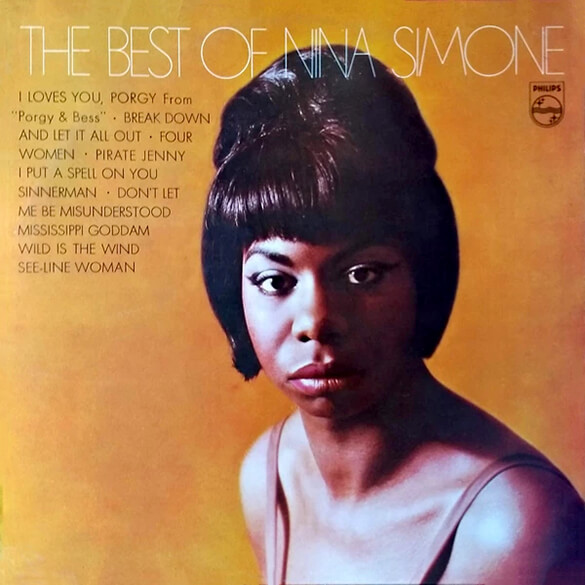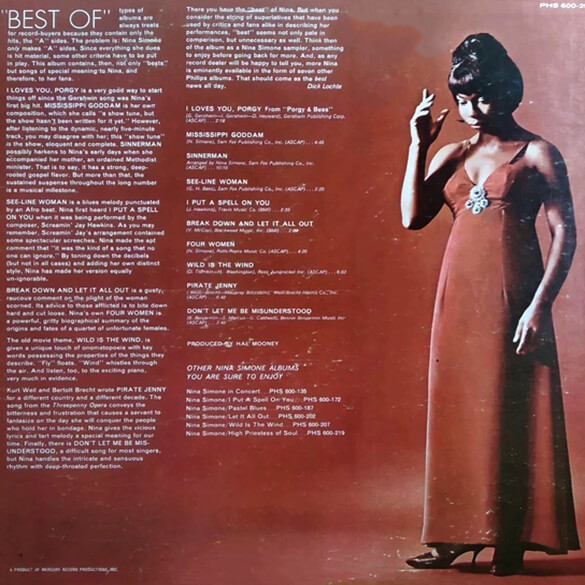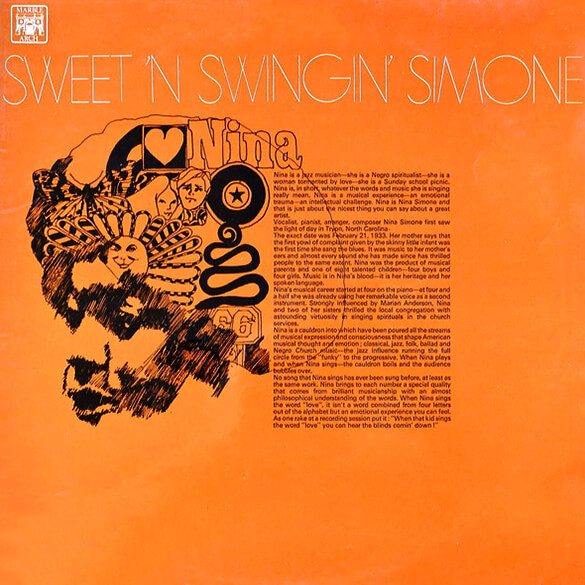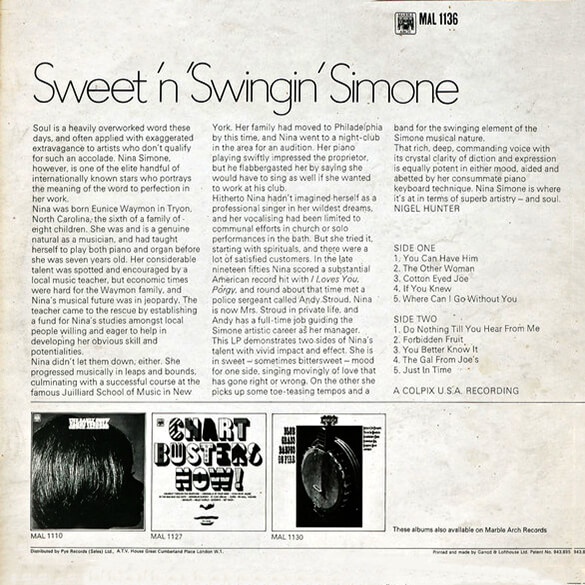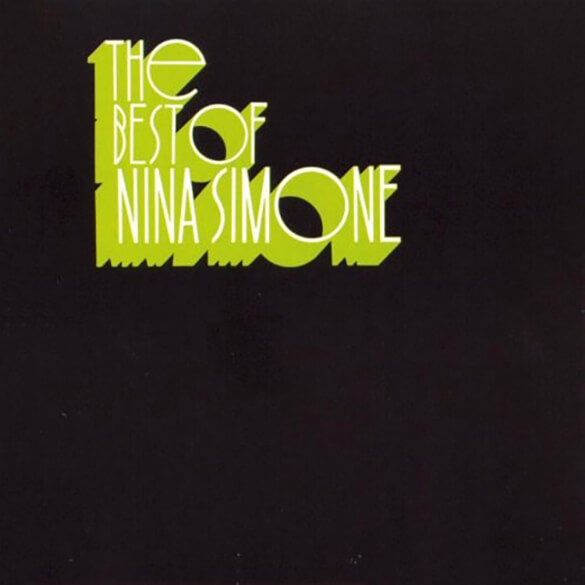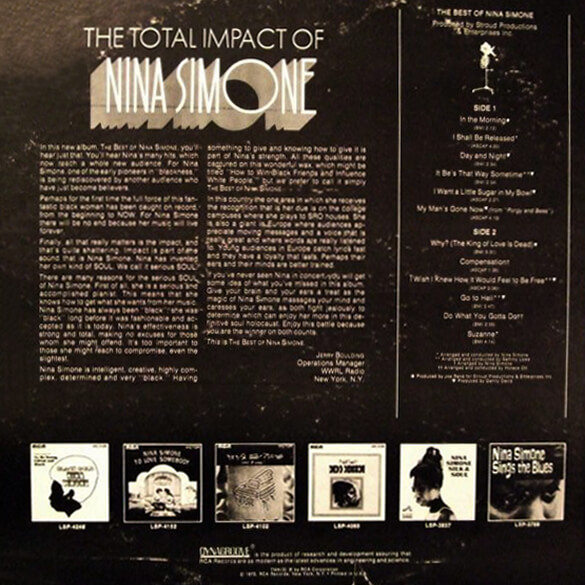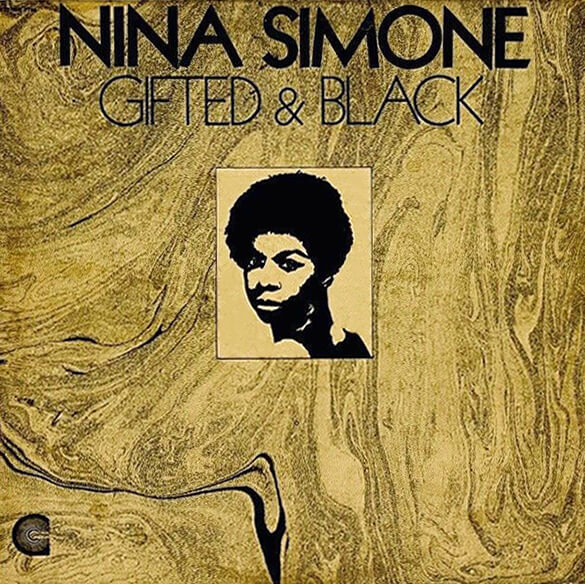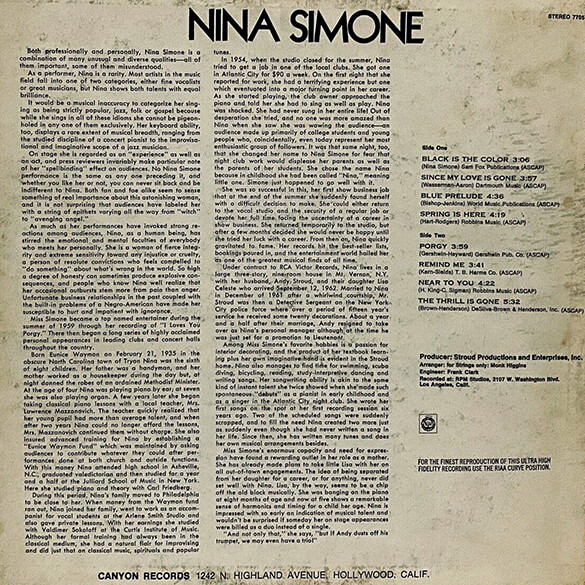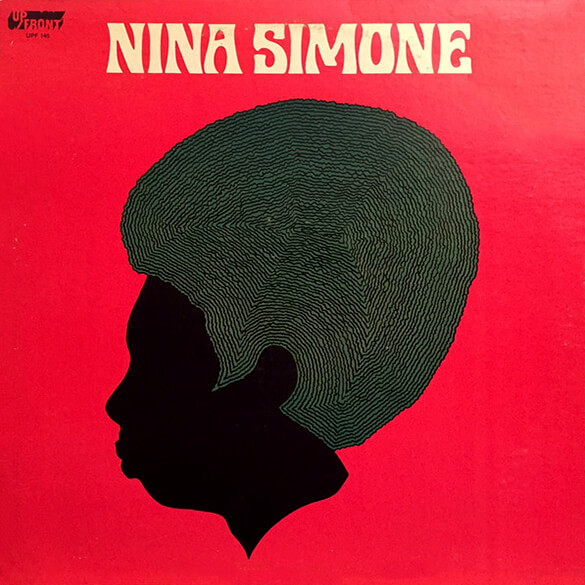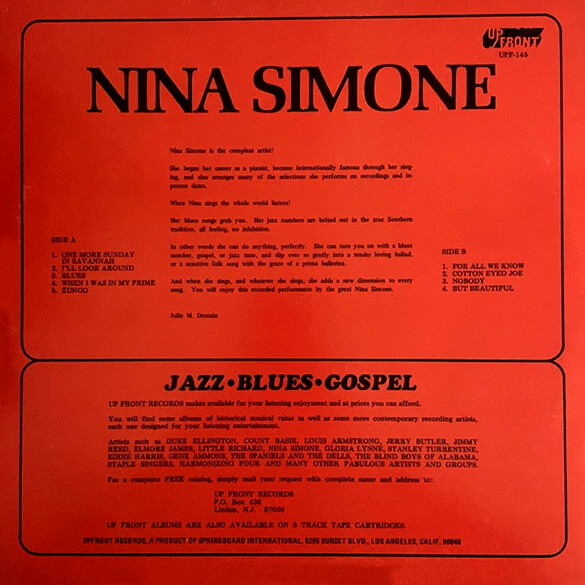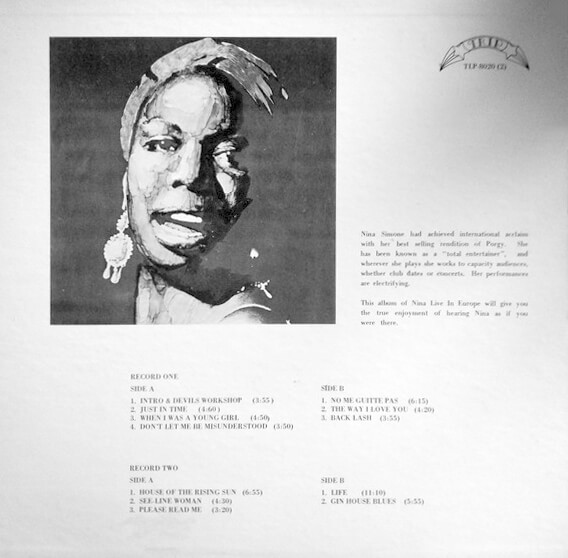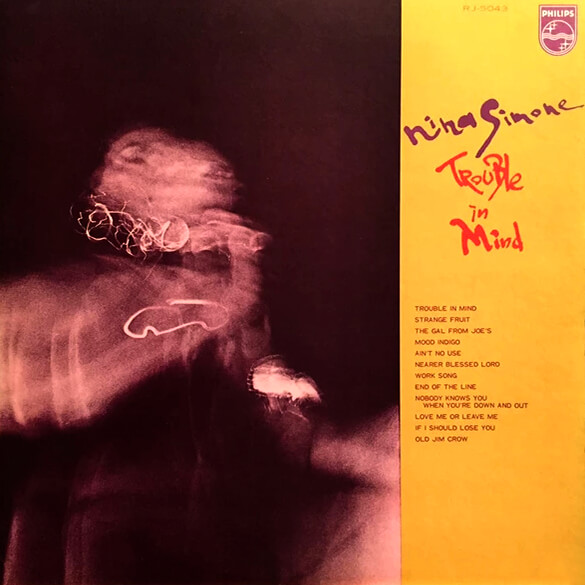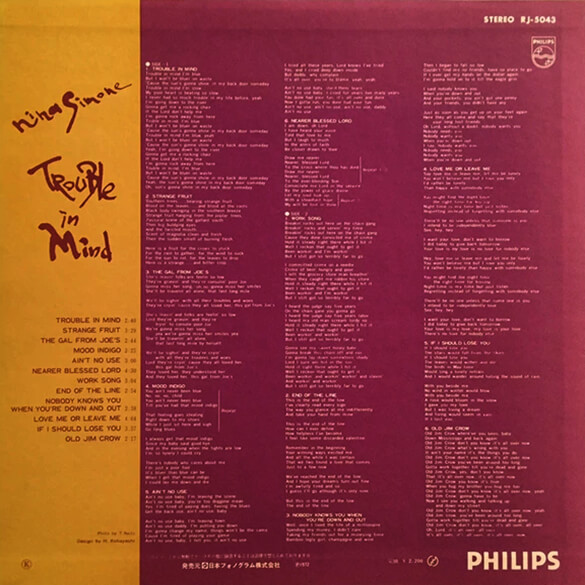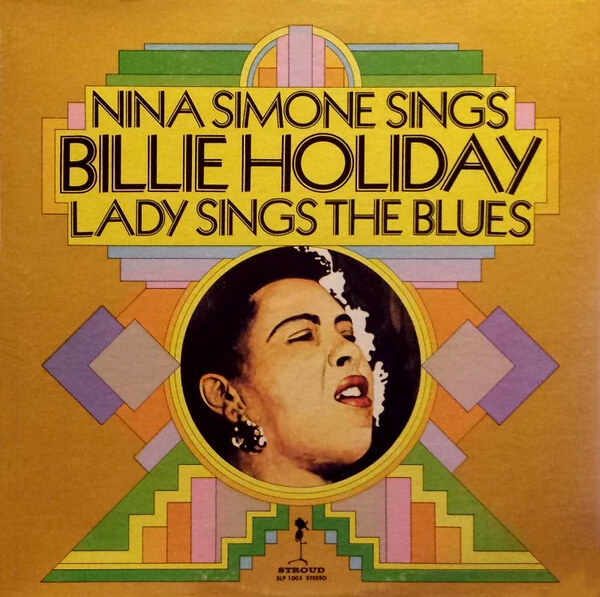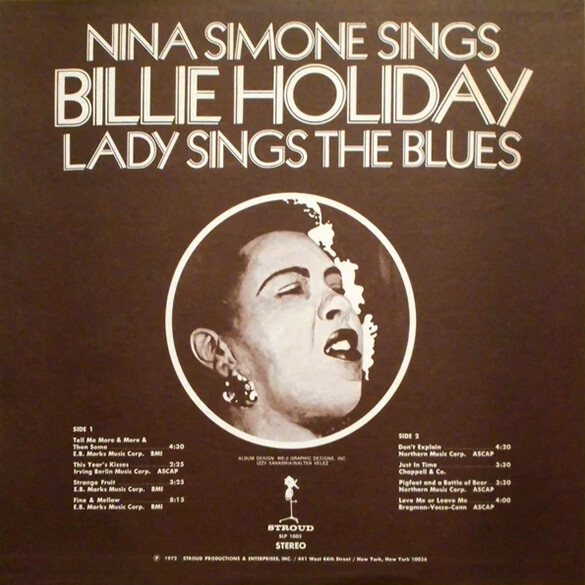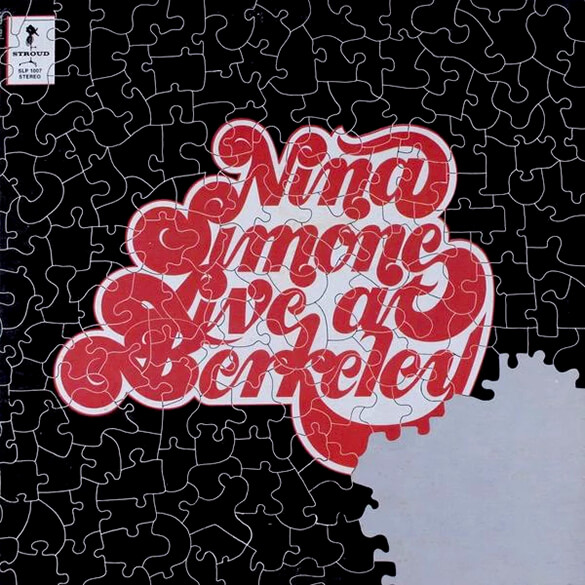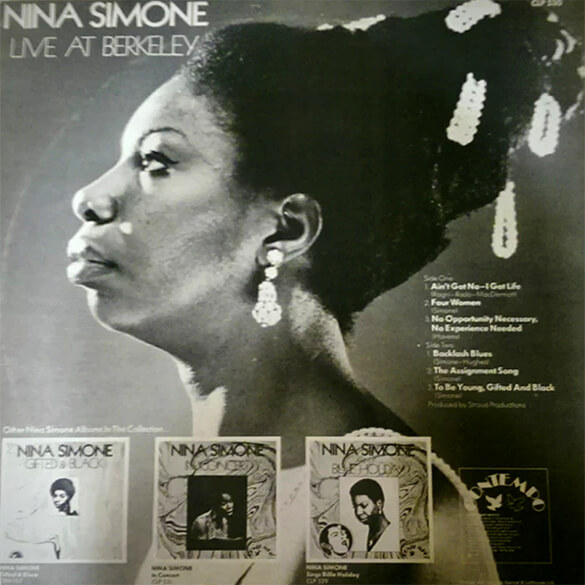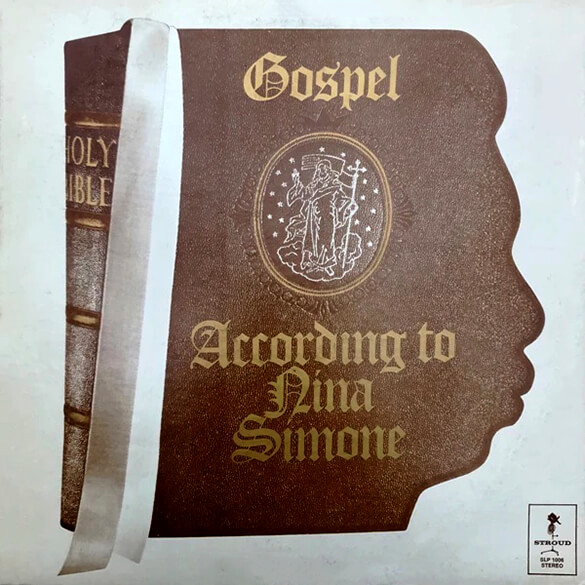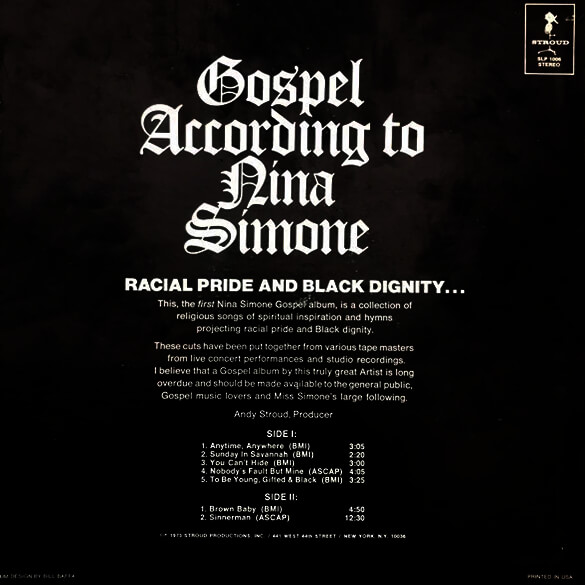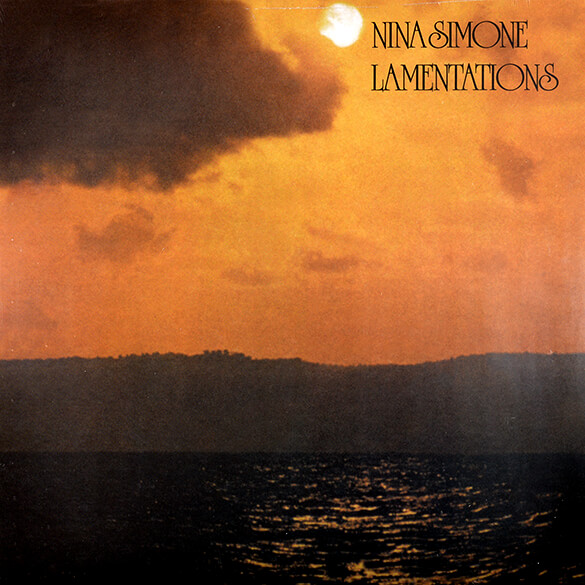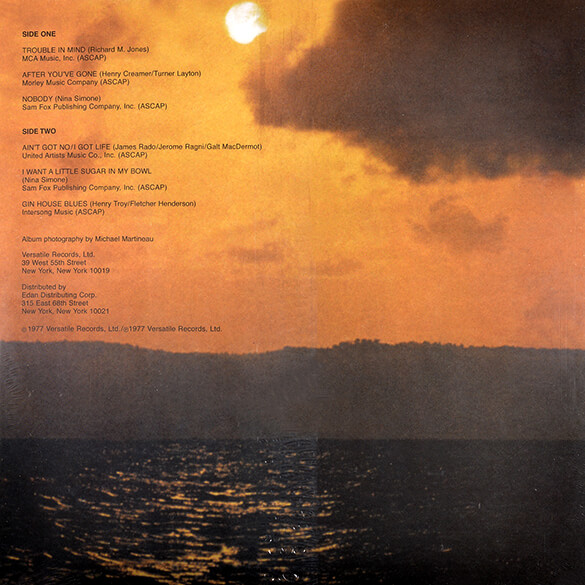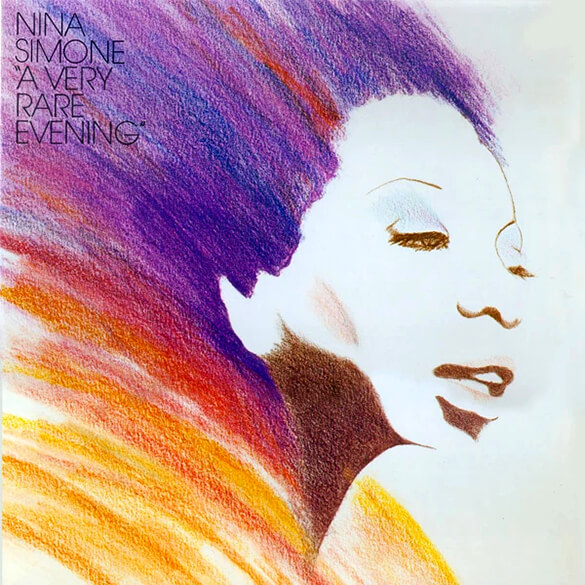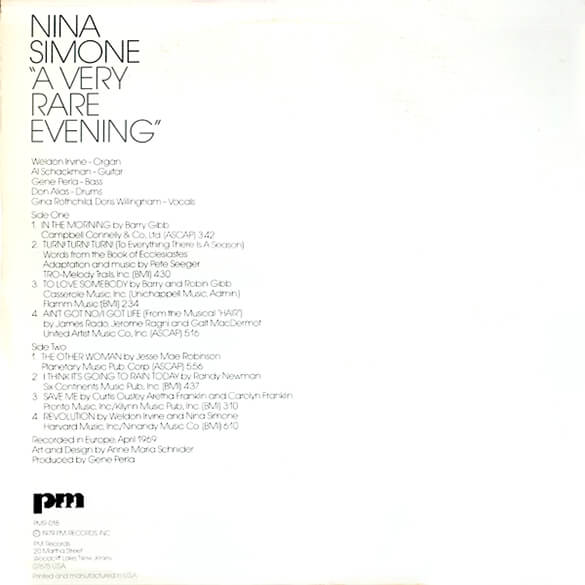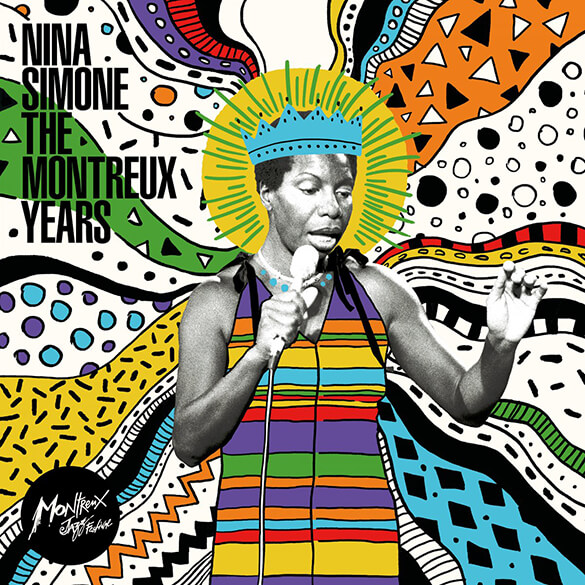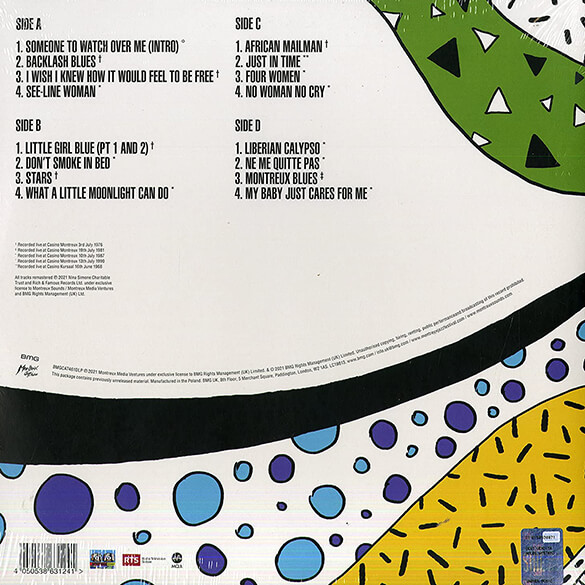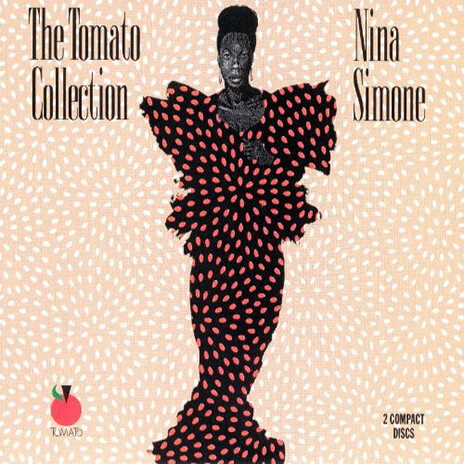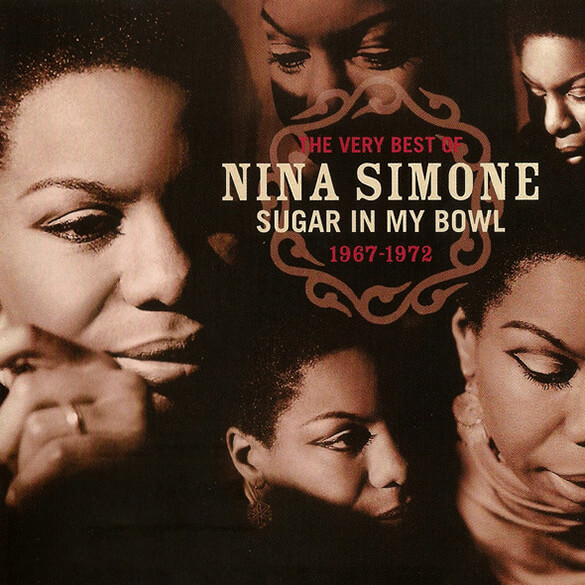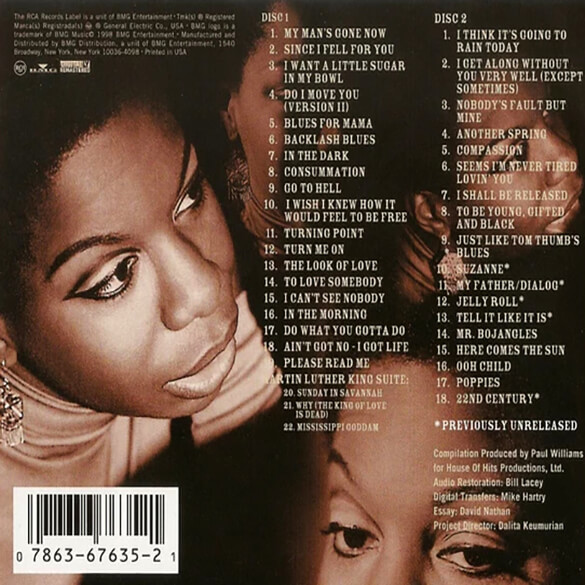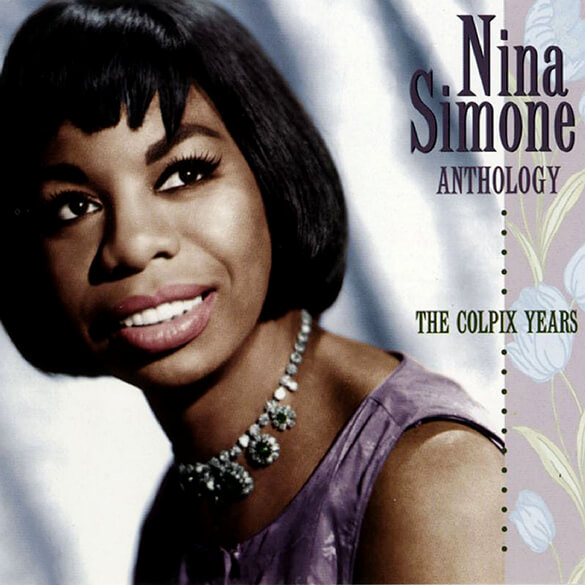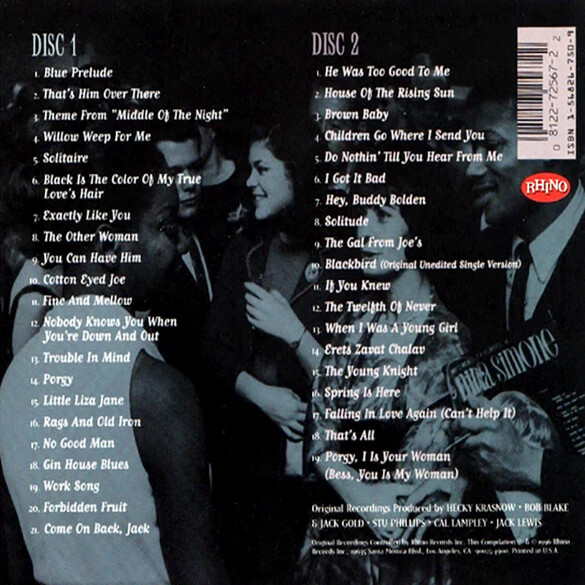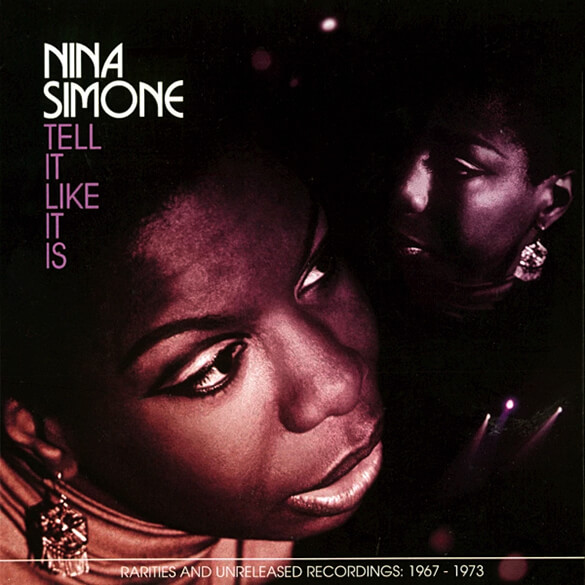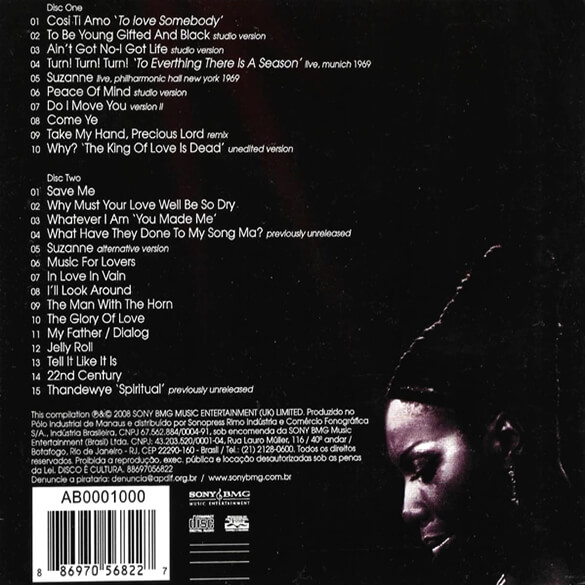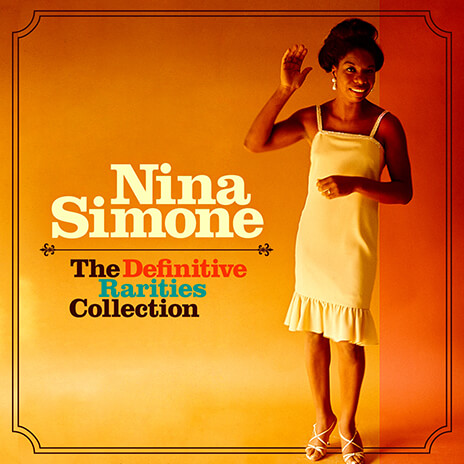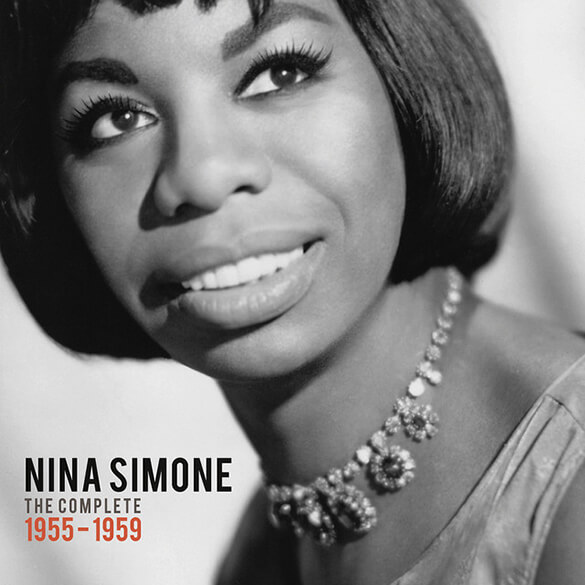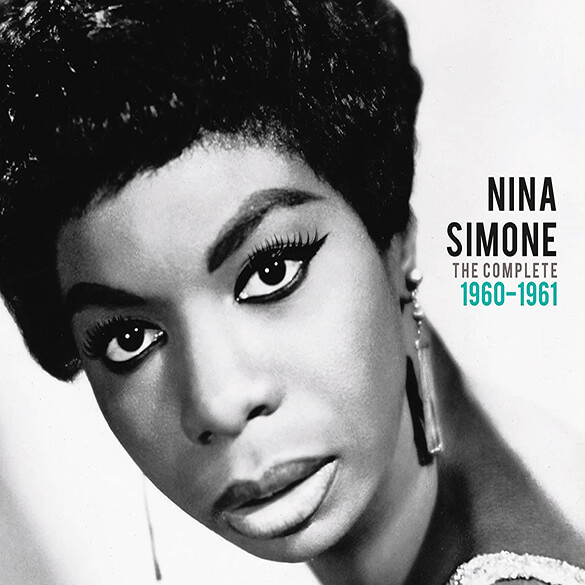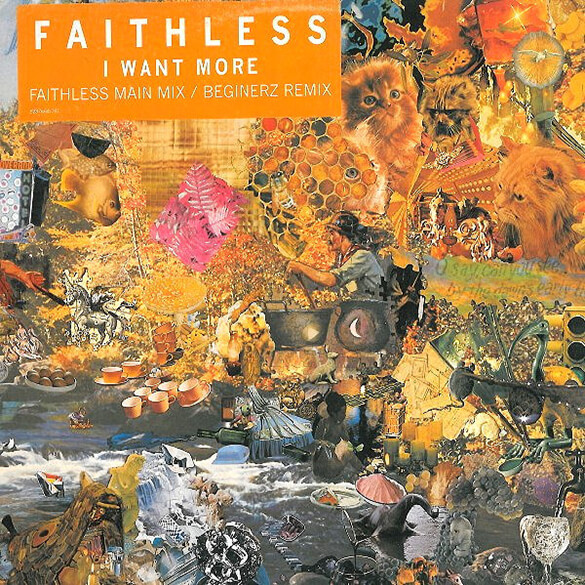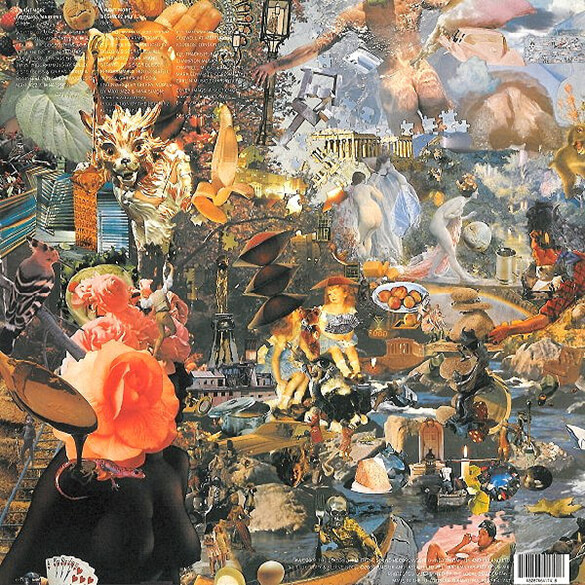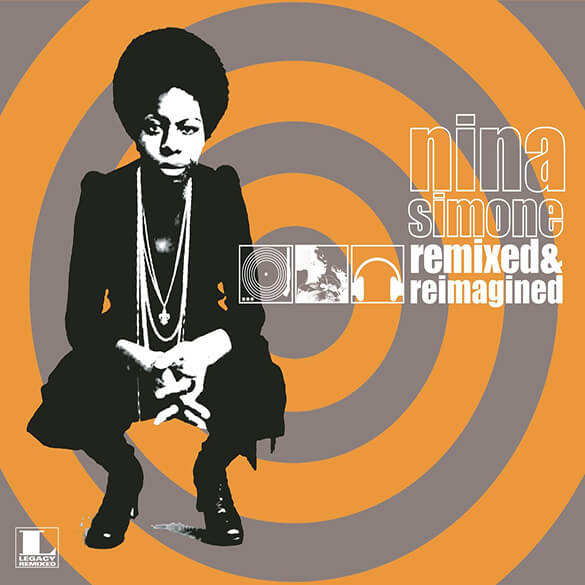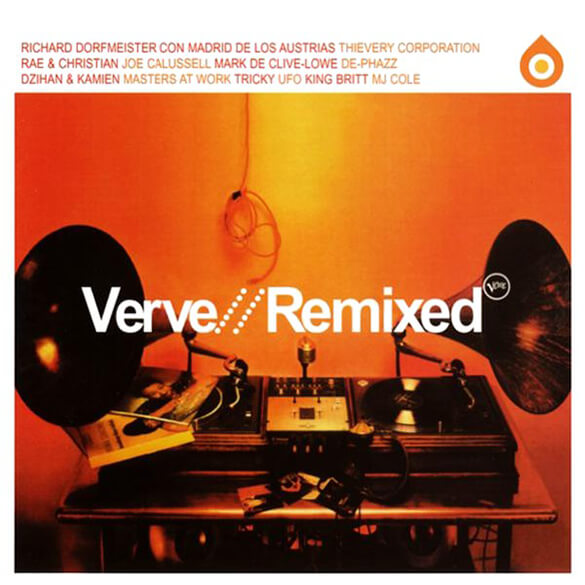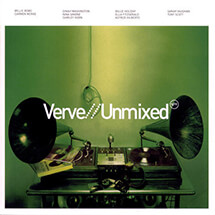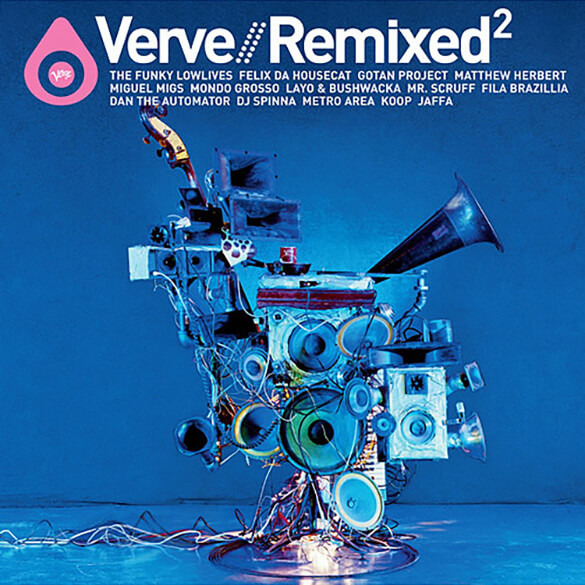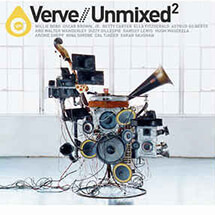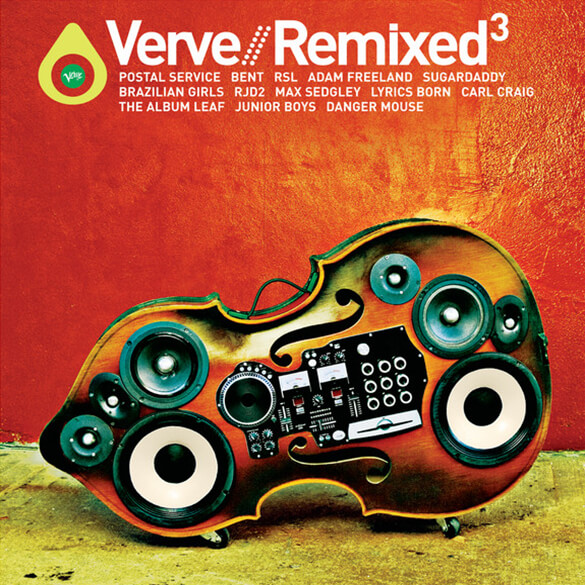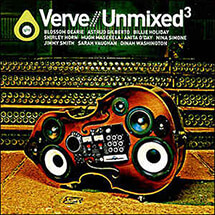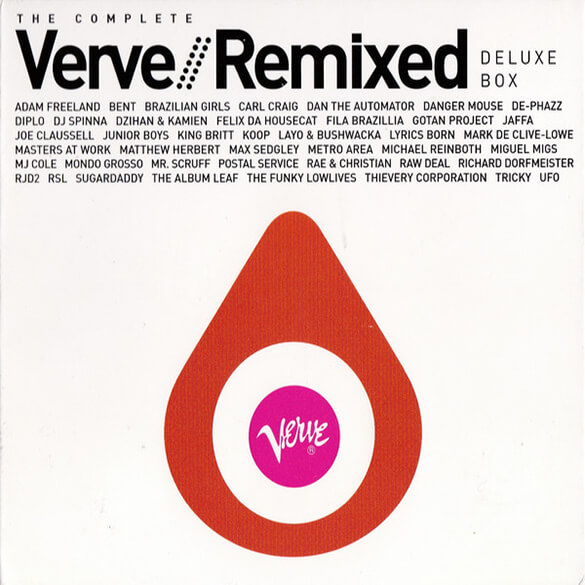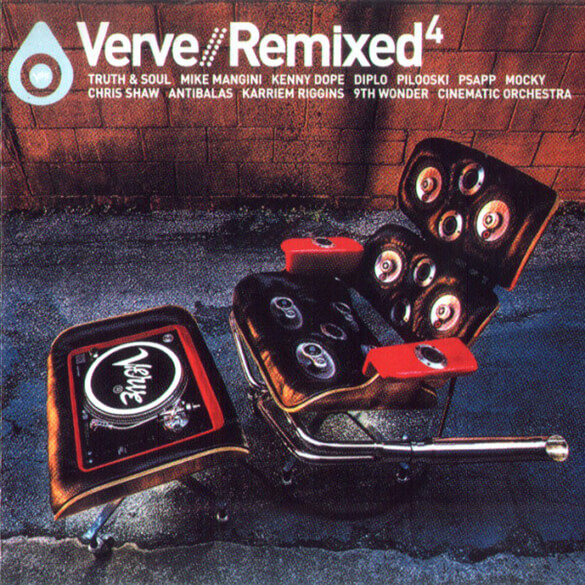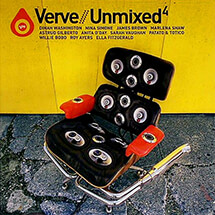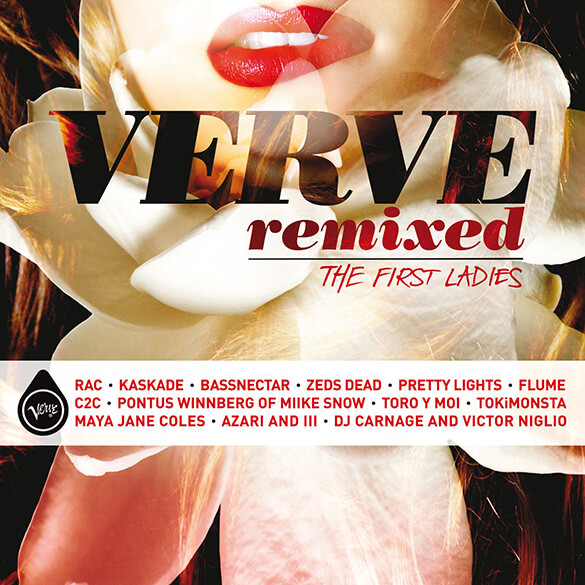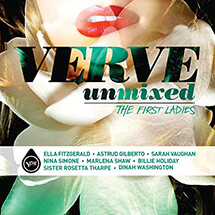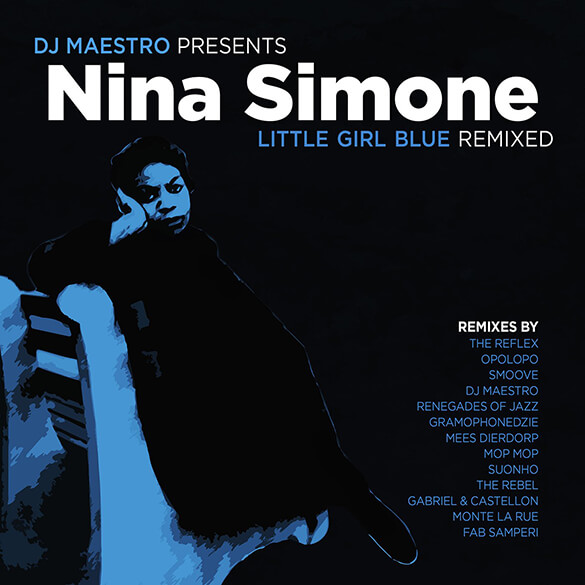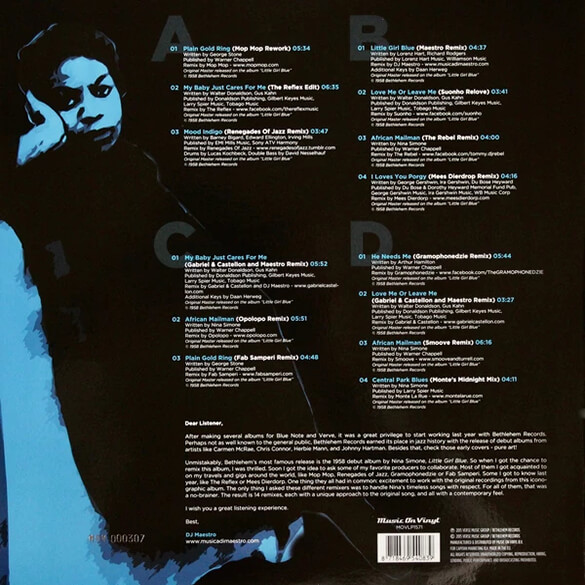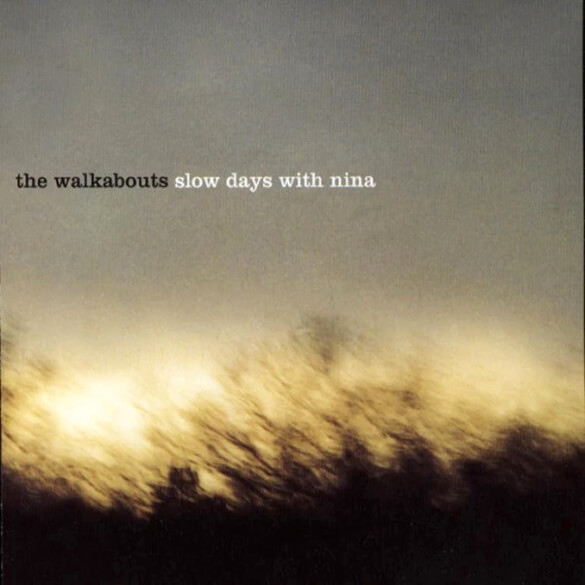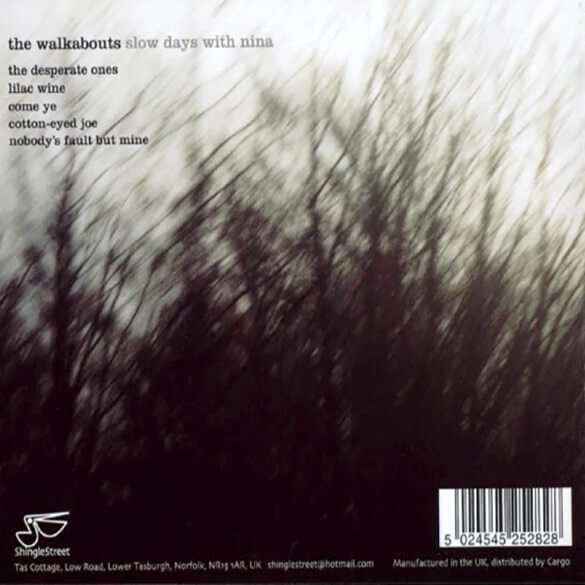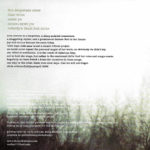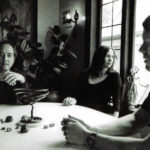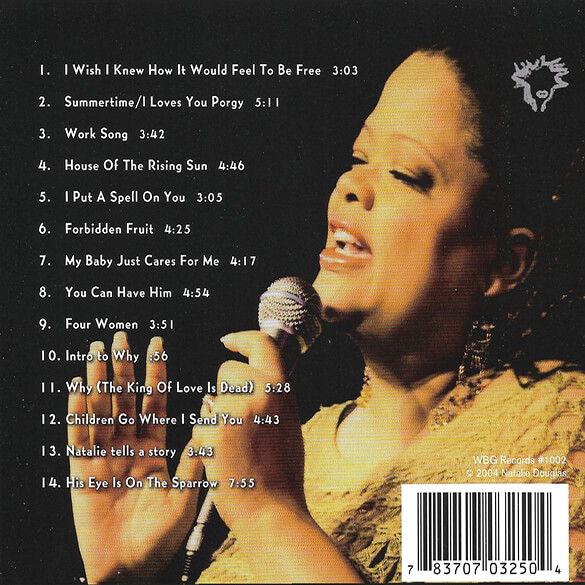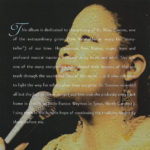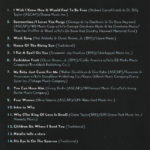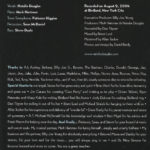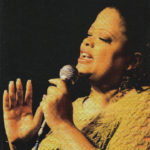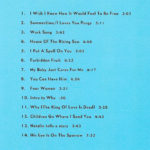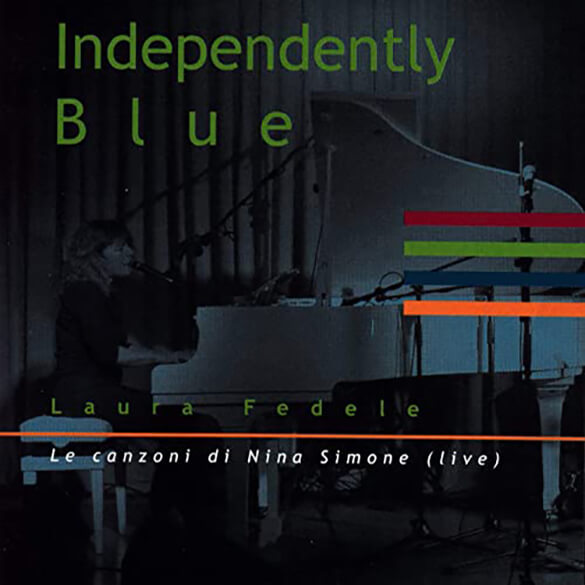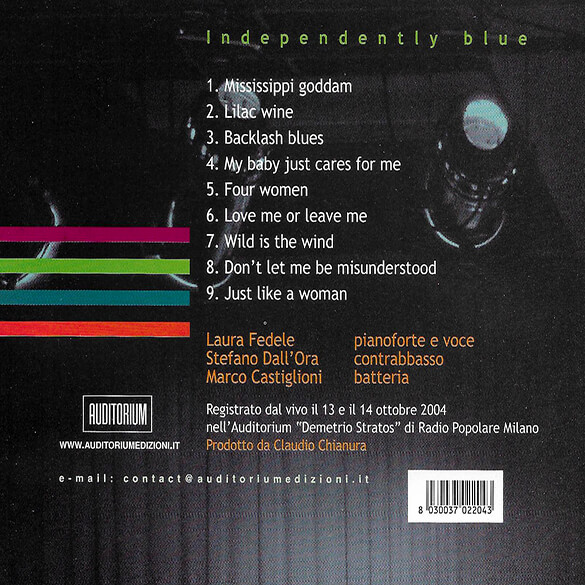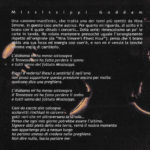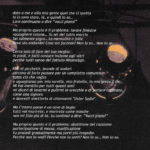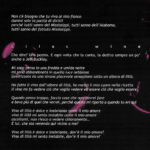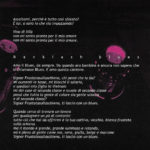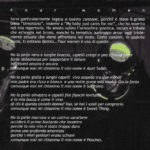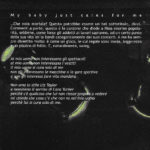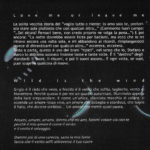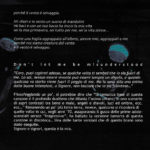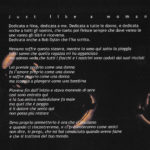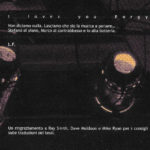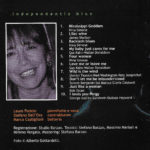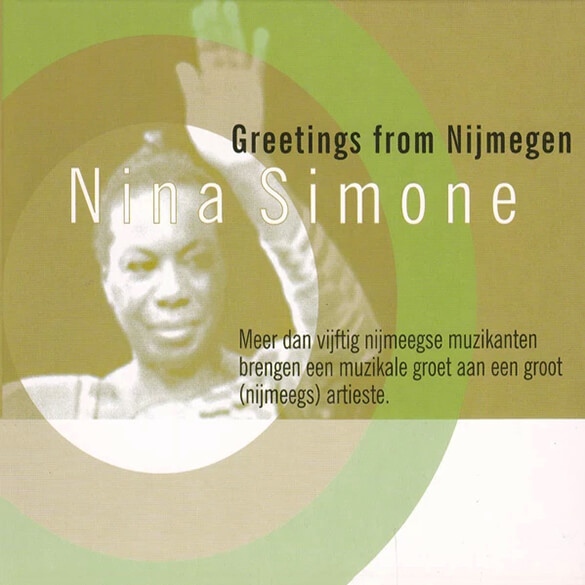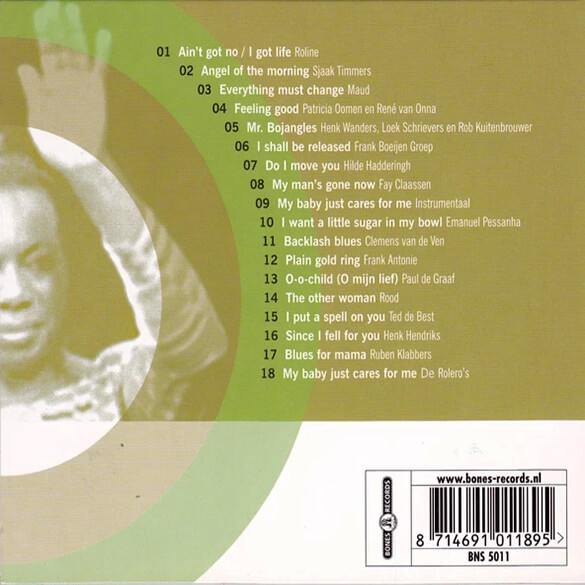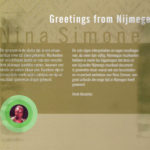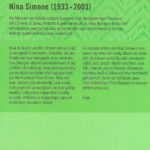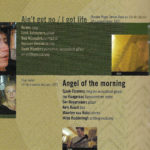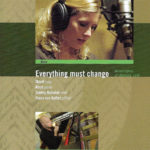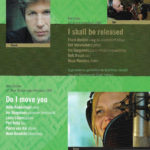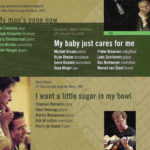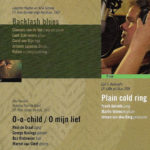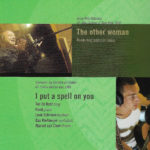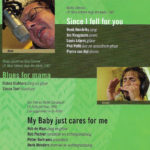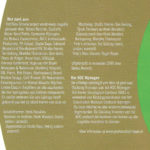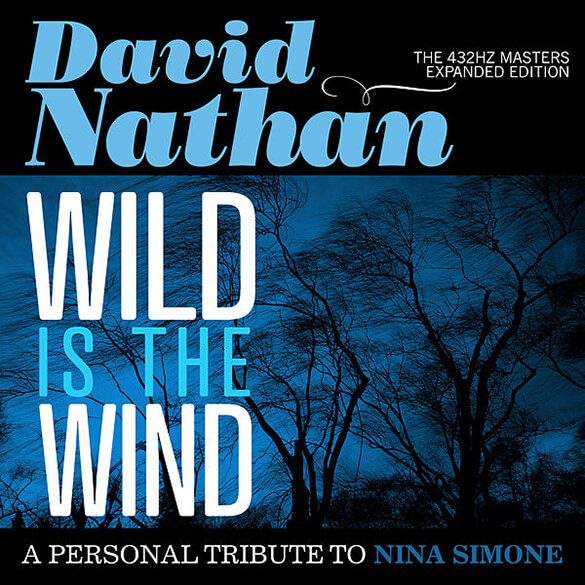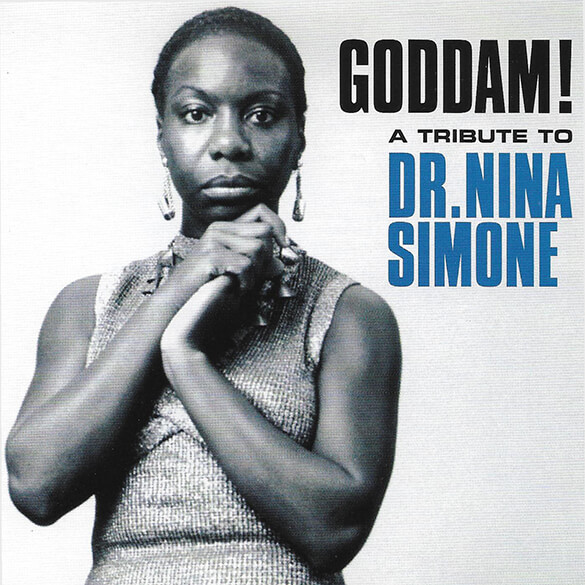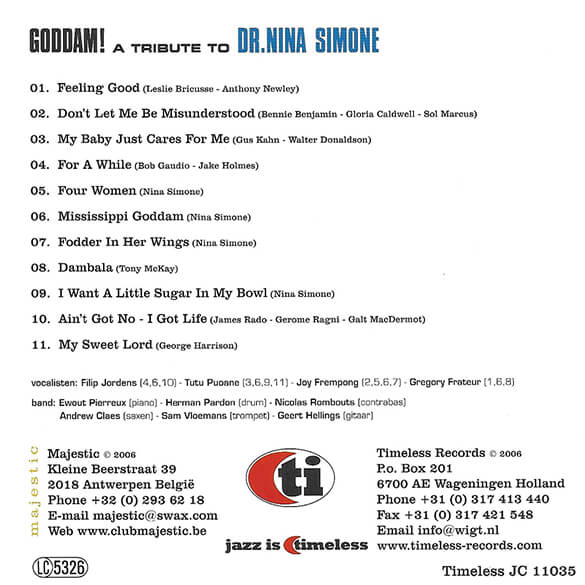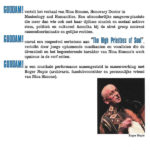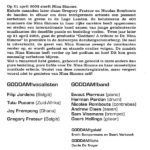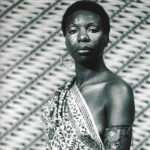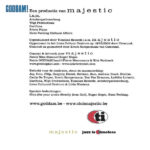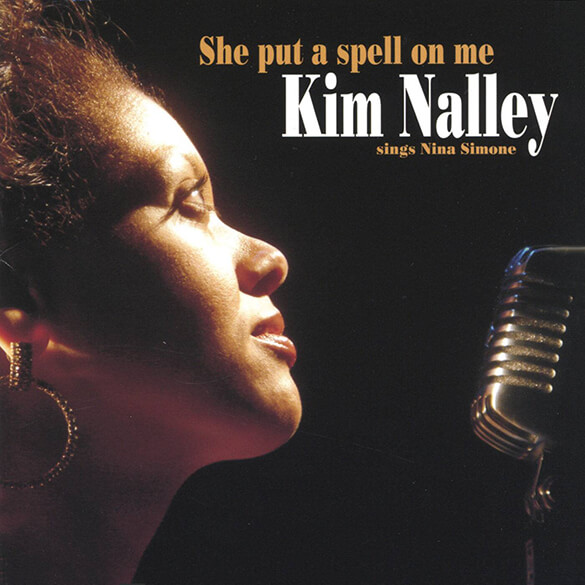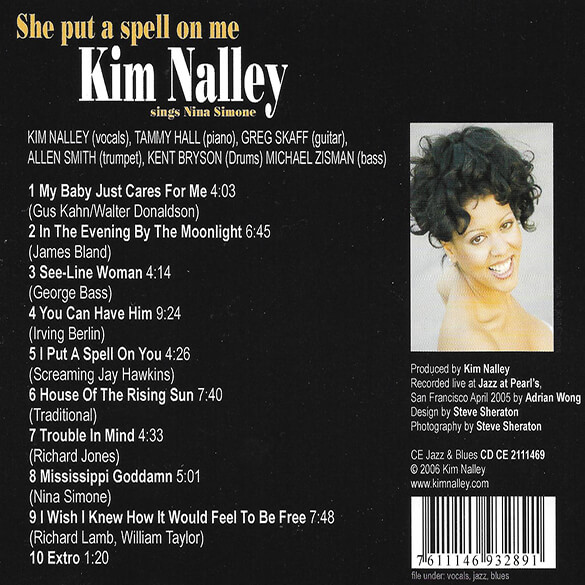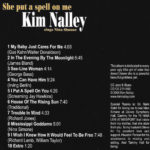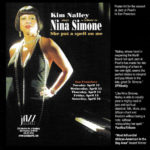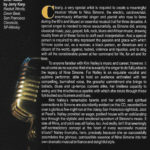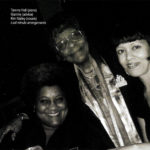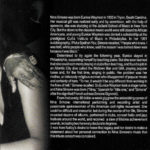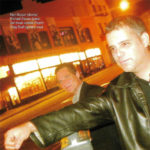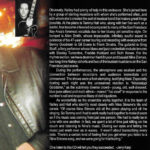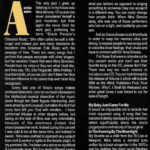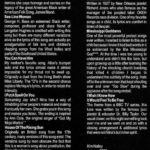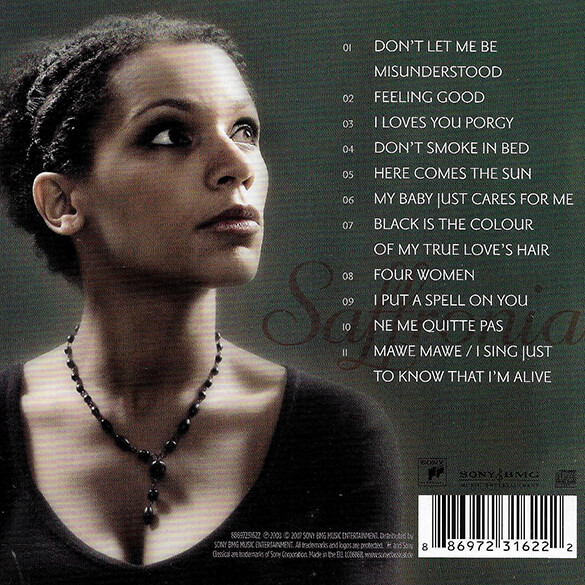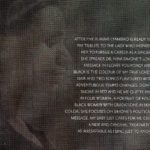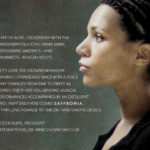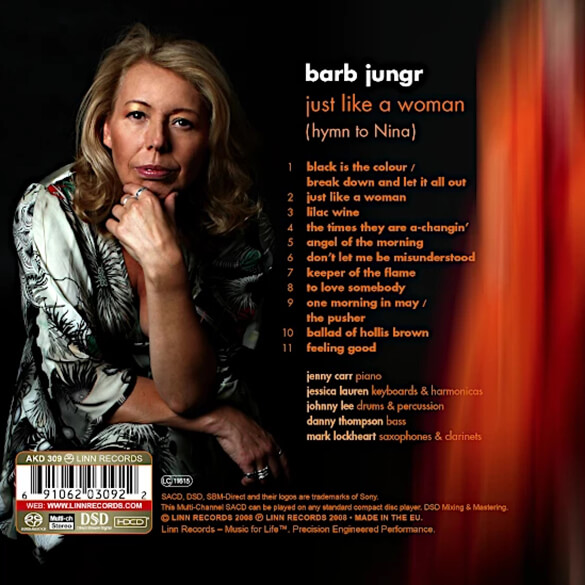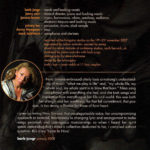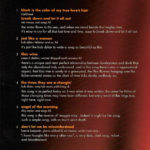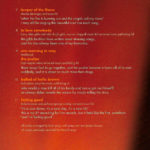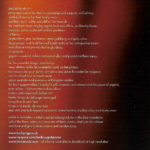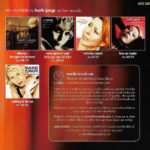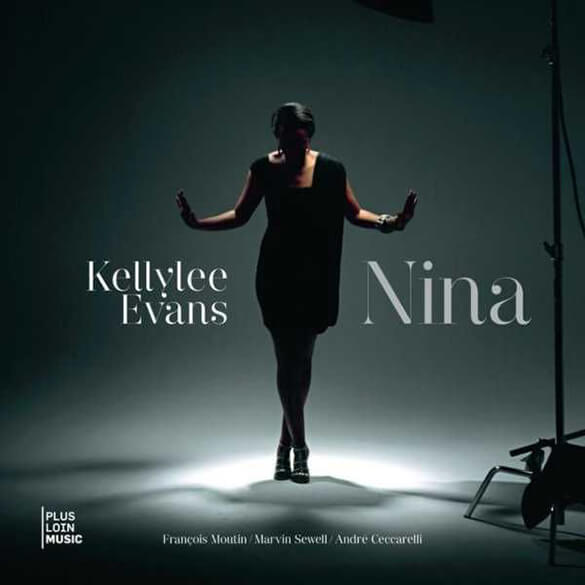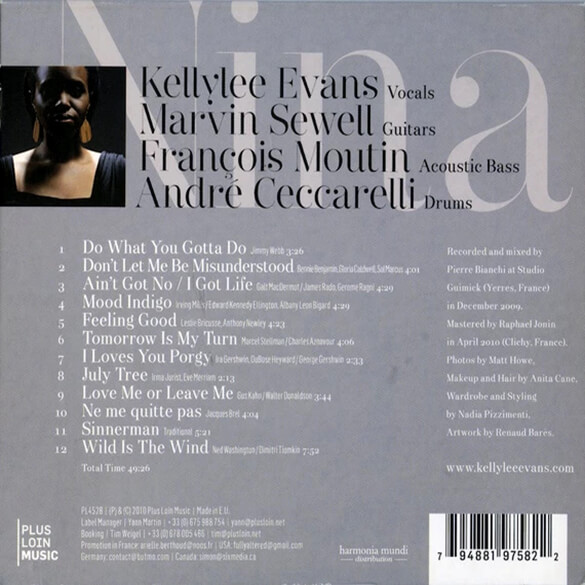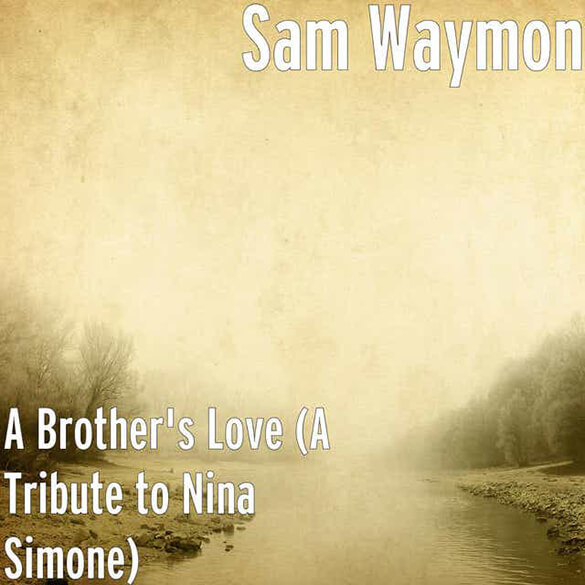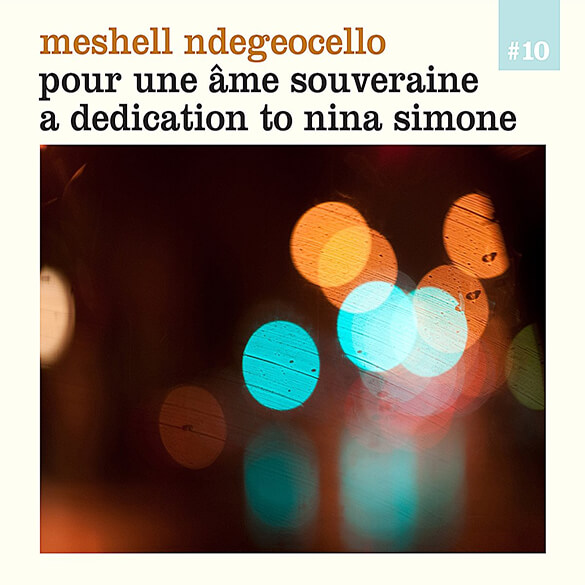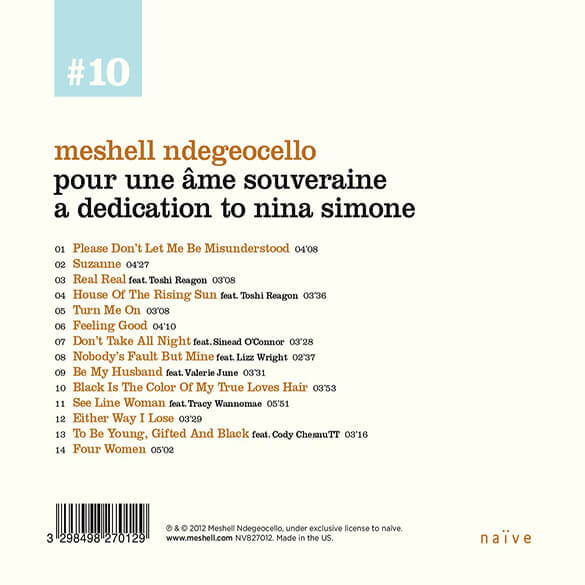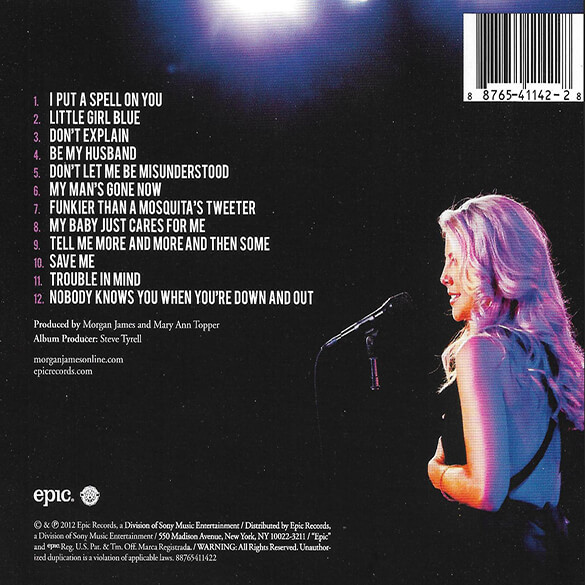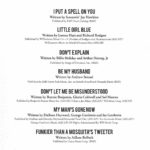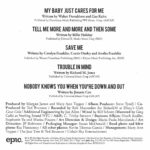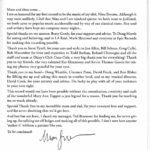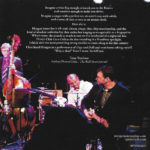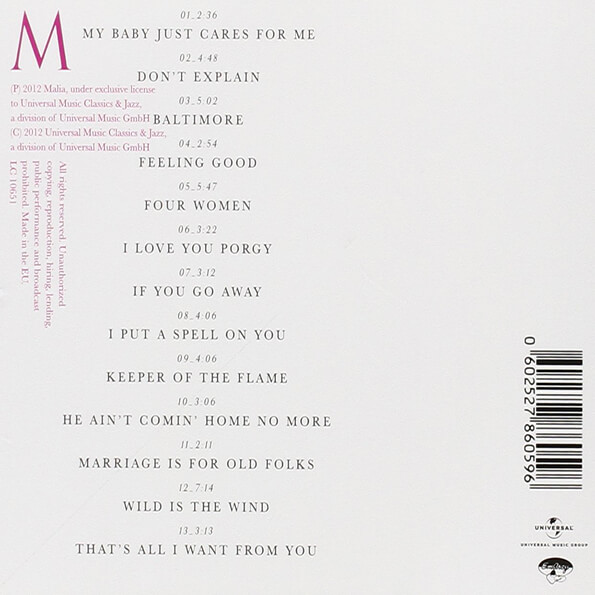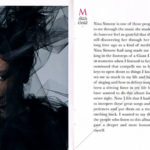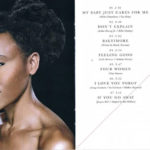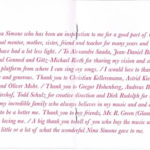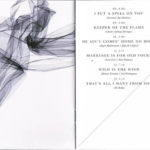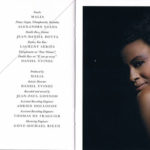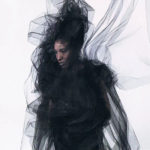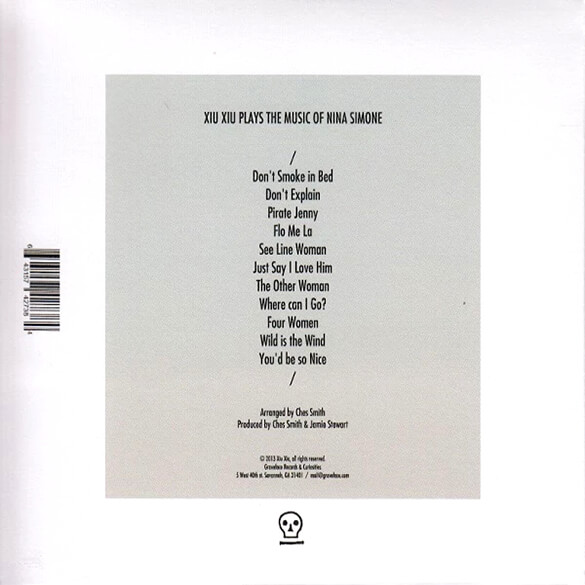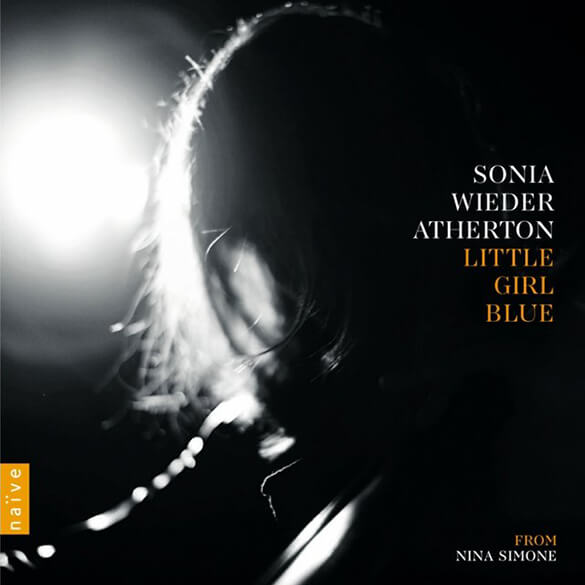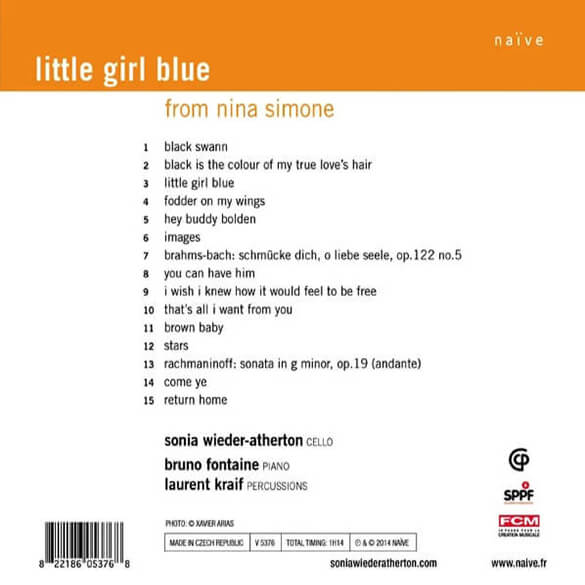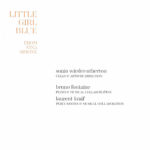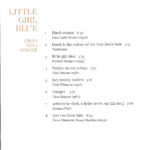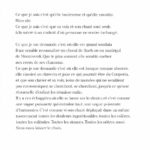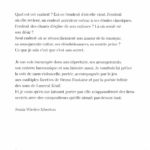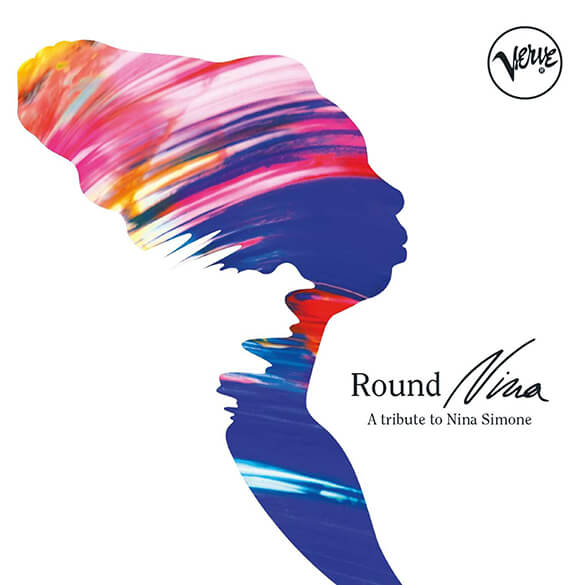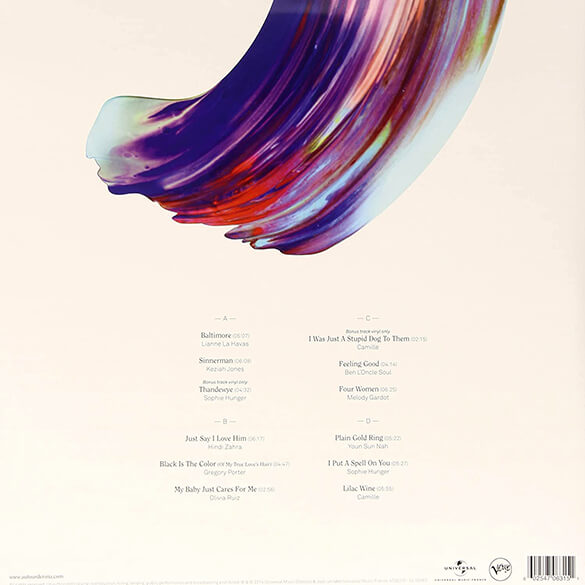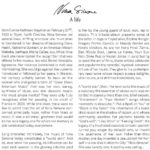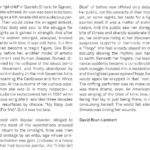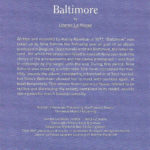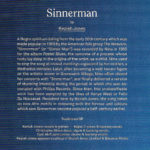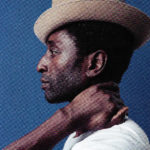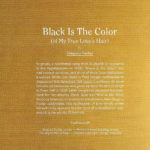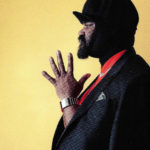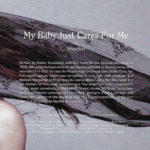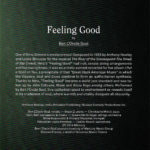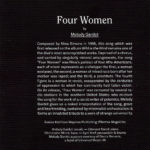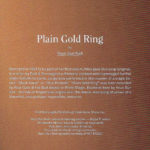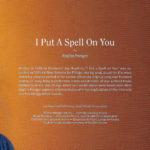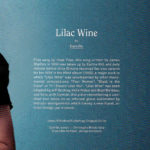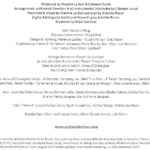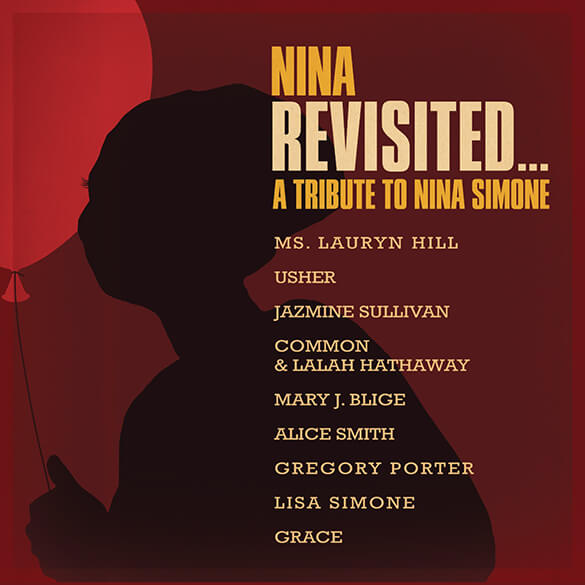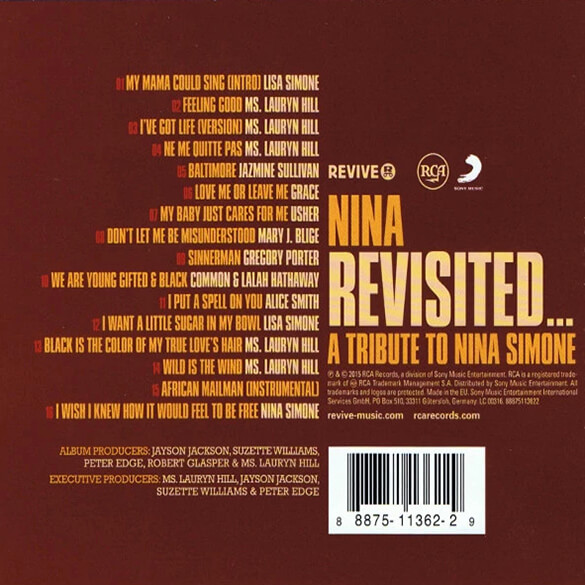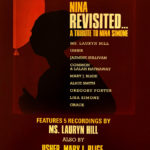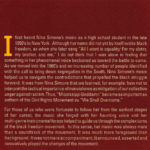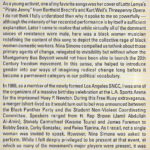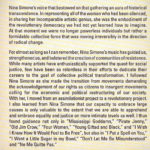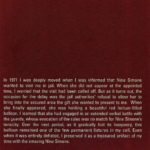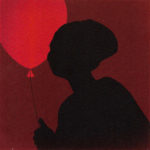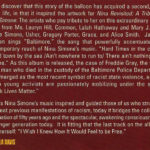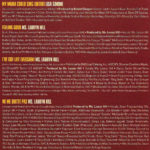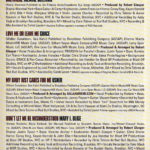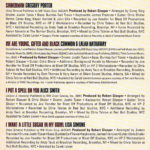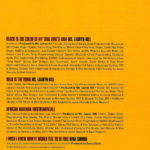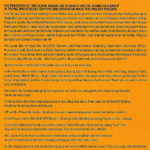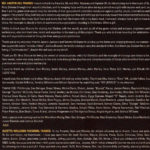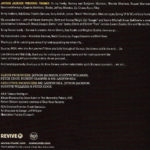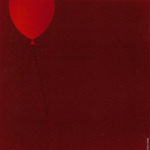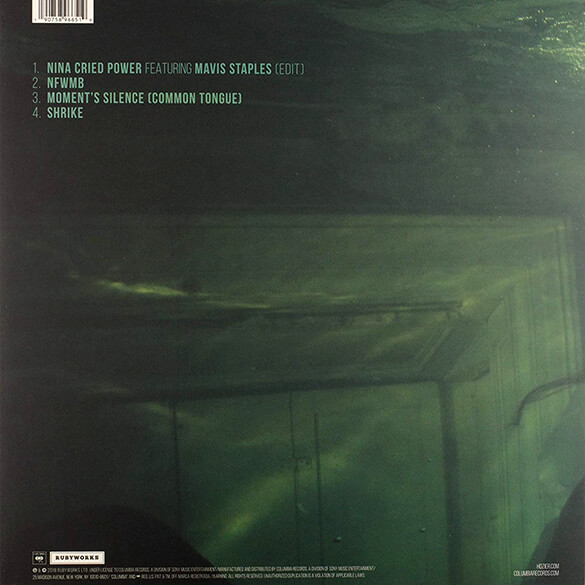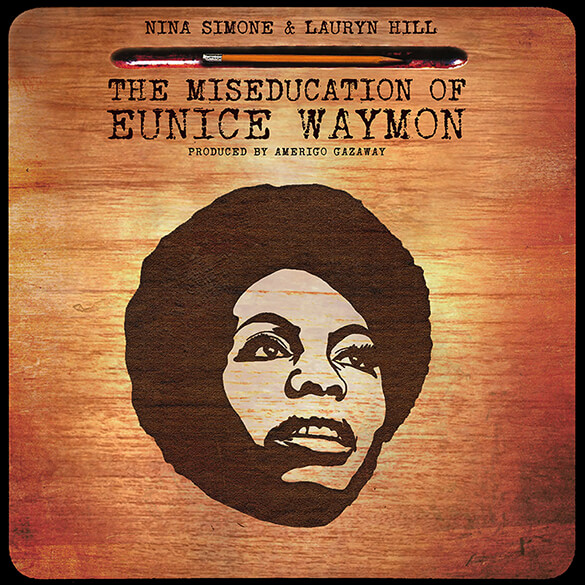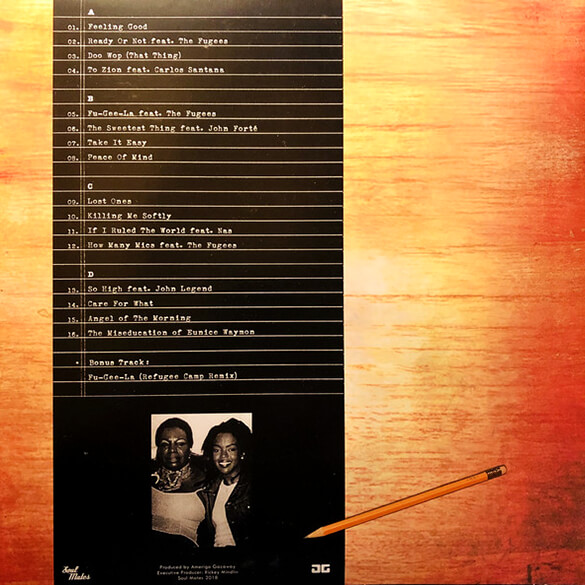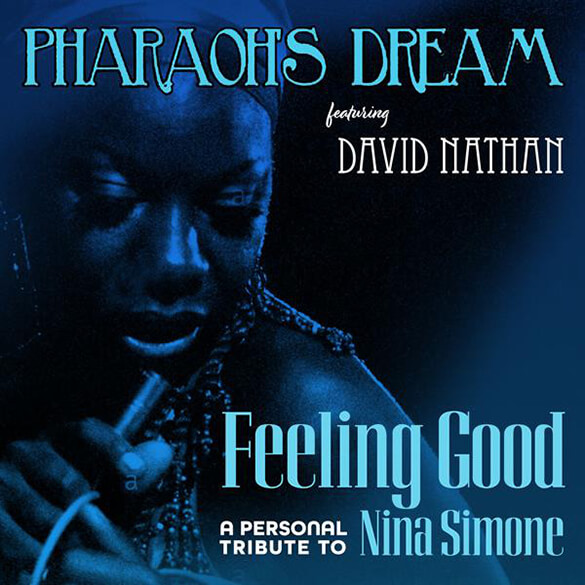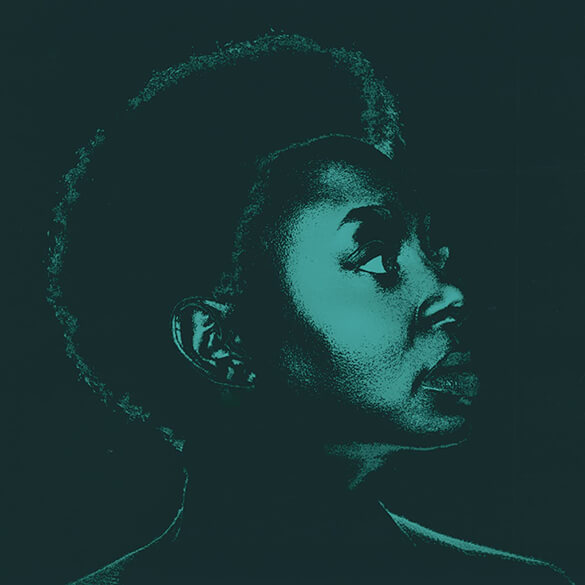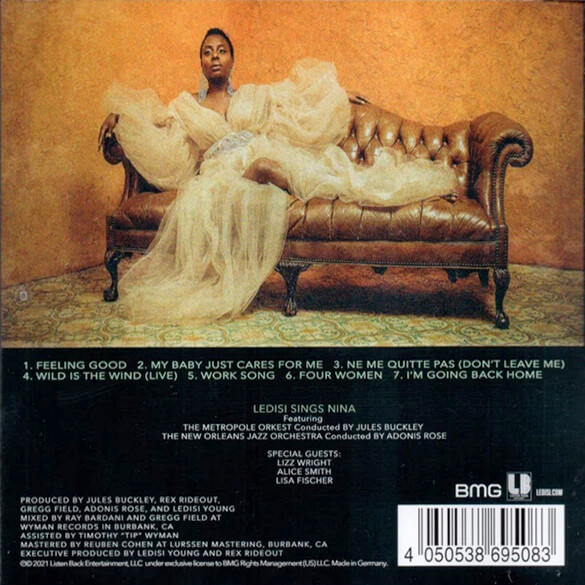- I Loves You Porgy
- Since My Love Has Gone
- Black Is The Color Of My True Love’s Hair
- Lovin’ Woman
- Baubles, Bangles, and Beads
- Nina Simone – vocals, piano, arrangements
- Burt Portnoy – cover design
Recording session: Atlantic City – 1956
Lawsuit:
In December of 1964 Nina Simone filed a lawsuit against Premier Albums and RH Macy for the unauthorized release of “Starring Nina Simone” (with George Wallington). Nina claimed that the LP was issued without her knowledge or consent.
The recording was in fact a demo that Nina had recorded and was never meant for commercial release.
In February of 1965 Premier Records made an out-of-court settlement on the suit.
Liner notes:
Whether it be a folk song, a balled, or cool jazz, Nina Simone leaves her audience completely captivated.
One of Nina’s first big breaks happened when she appeared at the Village Vanguard. A pin could be heard…her audience was left with soaring emotions.
She accompanied herself on the piano and then rose to the mike only to make the crowds watching clap for joy and beg for more of her distinctive style.
From the Vanguard her climb upward began. She appeared at the posh Blue Angel once again making an old standard come out fresh and new. Her brilliant piano performance is foot stamping, exciting rhythm from first note to last.
This album features Nina at her best…she sets a mood that lingers long after your record player as been turned off.
ALTERNATE COVERS:

- I Loves You, Porgy
- Break Down and Let It All Out
- Four Women
- Pirate Jenny
- I Put A Spell On You
- Sinnerman
- Don’t Let Me Be Misunderstood
- Mississippi Goddam
- Wild Is The Wind
- See-Line Woman
- Nina Simone – vocals, piano, arrangements
- various personnel based on track source material
- Burt Portnoy – cover design
- Hal Mooney – producer
- Dick Lochte – liner notes
Catalog number: PHS 600-298
Liner notes:
“BEST OF” types of albums are always treats for record-buyers because they contain only the hits, the “A” sides. The problem is: Nina Simone only makes “A”sides. Since everything she has done is hit material, some other criteria have to be put in play. This album contains, then, not only “bests” but songs of special meaning to Nina, and therefore, to her fans.
I LOVES YOU, PORGY is a very good way to start things off since the Gershwin song was Nina’s first big hit. MISSISSIPPI GODDAM is her own composition, which she calls “a show tune, but the show hasn’t been written for it yet.” However, after listening to the dynamic, nearly five minute track, you may disagree with her; this “show tun” is the show, eloquent and complete. SINNERMAN possibly harkens to Nina’s early days when she accompanied her mother, an ordained Methodist minister. That is to say, it has a strong, deep-rooted gospel flavor. But more than that, the sustained suspense throughout the long number is a musical milestone.
SEE-LINE WOMAN is a blues melody punctuated by an Afro beat. Nina first heard I PUT A SPELL ON YOU when it was being performed by the composer, Screamin’ Jay Hawkins. As you may remember, Screamin’ Jay’s arrangement contained some spectacular screeches. Nina made the apt comment that “it was the kind of a song that no one can ignore.” By toning down the decibels (but not in all cases) and adding her own distinct style, Nina has made her version equally un-ignorable.
BREAK DOWN AND LET IT ALL OUT is a gutsy, raucous comment on the plight of the woman scorned. Its advice to those afflicted is to bite down hard and cut loose. Nina’s own FOUR WOMEN is a powerful, gritty biographical summary of the origins and fates of a quartet of unfortunate females.
The old movie theme, WILD IS THE WIND, is given a unique touch of onomatopoeia with key words possessing the properties of the things they describe. “Fly” floats. “Wind” whistles through the air. And listen, too, to the exciting piano, very much in evidence.
Kurt Weill and Bertolt Brecht wrote PIRATE JENNY for a different country and a different decade. The song from the Threepenny Opera conveys the bitterness and frustration that causes a savant to fantasize on the day she will conquer the people who hold her in bondage. Nina gives the vicious lyrics and tart melody a special meaning for our time. Finally, there is DON’T LET ME BE MISUNDERSTOOD, a difficult song for most singers, but Nina handles the intricate and sensuous rhythm with deep-throated perfection.
There you have the “best” of Nina. But when you consider the string of superlatives that have been used by critics and fans alike in describing her performances, “best” seems not only pale in comparison, but unnecessary as well. Think then of the album as a Nina Simone sampler, something to enjoy before going back for more. And, as any record dealer will be happy to tell you, more Nina is eminently available in the form of seven other Philips albums. That should come as the best news all day.
- You Can Have Him
- The Other Woman
- Cotton Eyed Joe
- If You Knew
- Where Can I Go Without You
- Do Nothin Till You Hear From Me
- Forbidden Fruit
- You Better Know It
- The Gal From Joe’s
- Just In Time
- Nina Simone – vocals, piano, arrangements
- various personnel based on track source material
- Nigel Hunter – liner notes
Catalog number: MAL 1136
Track source info:
- You Can Have Him — live recording from At Town Hall (1959)
- The Other Woman — live recording from At Town Hall (1959)
- Cotton Eyed Joe — live recording from At Town Hall (1959)
- If You Knew — live recording from At Carnegie Hall (1963)
- Where Can I Go Without You — from Forbidden Fruit (1961)
- Do Nothin Till You Hear From Me — from Sings Ellington (1962)
- Forbidden Fruit — from Forbidden Fruit (1961)
- You Better Know It — from Sings Ellington (1962)
- The Gal From Joe’s — from Sings Ellington (1962)
- Just In Time — live recording from At The Village Gate (1962)
Liner notes:
Nina is a jazz musician — she is a Negro spiritualist — she is a woman tormented by love — she is a Sunday school picnic. Nina is, in short, whatever the words and music she is singing really mean. Nina is a musical experience — an emotional trauma — an intellectual challenge. Nina is Nina Simone and that is just about the nicest thing you can say about a great artist.
Vocalist, pianist, arranger, composer Nina Simone first saw the light of day in Tryon, North Carolina. The exact date was February 21, 1933. Her mother says that the first yowl of complaint given by the skinny little infant was the first time she sang the blues. It was music to her mother’s ears and almost every sound she has made since has thrilled people to the same extent. Nina was the product of musical parents and one of the eight talented children — four boys and four girls. Music is in Nina’s blood — it is her heritage and her spoken language.
Nina’s musical career started at four on the piano — at four and a half she was already using her remarkable voice as a second instrument. Strongly influenced by Marian Anderson, Nina and two of her sisters thrilled the local congregation with astounding virtuosity in singing spirituals in the church services.
Nina is a cauldron into with have been poured all the streams of musical expression and consciousness that shape American musical thought and emotion: classical, jazz, folk, ballad, and Negro Church music — the jazz influence running the full circle from the “funky” to the progressive. When Nina plays and when Nina sings — the cauldron boils and the audience bubbles over.
No song that Nina sings has ever been sung before, at least as the same work. Nina brings to each number a special quality that comes from brilliant musicianship with an almost philosophical understanding of the words. When Nina sings the word “love”, it isn’t a word from four letters out of the alphabet but an emotional experience you can feel. As one rake at a recording session put it: “When that kid sings the word “love” you can hear the blinds comin’ down!”
————————
Soul is a heavily overworked word these days, and often applied with exaggerated extravagance to artists who don’t qualify for such an accolade. Nina Simone, however, is one of the elite handful of internationally known stars who portrays the meaning of the word to perfection in her work.
Nina was born Eunice Waymon in Tryon, North Carolina, the sixth of a family of eight children. She was and is a genuine natural as a musician, and had taught herself to play both piano and organ before she was seven years old. Her considerable talent was spotted and encouraged by a local music teacher, but economic times were hard for the Waymon family, and Nina’s musical future was in jeopardy. The teacher came to the rescue by establishing a fund for Nina’s studies amongst local people willing and eager to help in developing her obvious skill and potentialities.
Nina didn’t let them down, either. She progressed musically in leaps and bounds, culminating with a successful course at the famous Juilliard School of Music in New York. Her family had moved to Philadelphia by this time, and Nina went to a night-club in the area for an audition. Her piano playing swiftly impressed the proprietor, but he flabbergasted her by saying she would have to sing as well if she wanted to work at his club.
Hitherto Nina hadn’t imagined herself as a professional singer in her wildest dreams, and her vocalizing had been limited to communal efforts in church or solo performances in the bath. But she tried it, starting with spirituals, and there were a lot of satisfied customers. In the late nineteen fifties Nina scored a substantial American record hit with I Loves You, Porgy, and round about that time met a police sergeant called Andy Stroud. Nina is now Mrs. Stroud in private life, and Andy has a full-time job guiding the Simone artistic career as her manager.
This LP demonstrates two sides of Nina’s talent with vivid impact and effect. She is in sweet — sometimes bittersweet — mood for one side, singing movingly of love that has gone right or wrong. On the other she picks up some toe-teasing tempos and a band for the swinging element of the Simone musical nature.
That rich, deep, commanding voice with its crystal clarity of diction and expression is equally potent in either mood, aided and abetted by her consummate piano keyboard technique. Nina Simone is where it’s at in terms of superb artistry — and soul.
- In The Morning
- I Shall Be Released
- Day and Night
- It Be’s That Way Sometimes
- I Want A Little Sugar In My Bowl
- My Man’s Gone Now
- Why? (The King of Love Is Dead)
- Compensation
- I Wish I Knew How It Would Feel To Be Free
- Go To Hell
- Do What You Gotta Do
- Suzanne
- Nina Simone – vocals, piano, arrangements
- various personnel based on track source material
- Andy Stroud – producer
- Jerry Boulding – liner notes
Catalog number: LSP-4374
Liner notes:
In this new album, The Best of Nina Simone, you’ll hear just that. You’ll hear Nina’s many hits, which now reach a whole new audience. For Nina Simone, one of the early pioneers in “blackness” is being rediscovered by another audience who have just become believers.
Perhaps for the first time the full force of this fantastic Black woman has been caught on record, from the beginning to NOW. For Nina Simone there will be no end because her music will live forever.
Finally, all that really matters is the impact, and that’s quite shattering. Impact is part of the sound that is Nina Simone. Nina has invented her own kind of SOUL. We call it serious SOUL.
There are many reasons for the serious SOUL of Nina Simone. First of all, she is a serious and accomplished pianist. This means that she knows how to get what she wants from her music. Nina Simone has always been “Black”; she was “Black” long before it was fashionable and accepted as it is today. Nina’s effectiveness is strong and total, making no excuses for those whom she might offend. It is too important to those she might reach to compromise even the slightest.
Nina Simone is intelligent, creative, highly complex, determined, and very “Black.” Having something to give and knowing how to give it is part of Nina’s strength. All these qualities are captured on this wonderful wax, which might be titled “How To Win Black Friends and Influence White People,” but we prefer to call it simply THE BEST OF NINA SIMONE.
In this country the one area in which she receives the recognition that is her due is on the college campuses where she plays to SRO houses. She is also a giant in Europe where audiences appreciate moving messages and a voice that is really great where words are really listened to. Young audiences in Europe catch lyrics fast and they have a loyalty that lasts. Perhaps their ears and their minds are better trained.
If you’ve never seen Nina in concert, you will get some idea of what you’ve missed in this album. Give your brain and your ears a treat as the magic of Nina Simone massages your mind and caresses your ears, as both fight jealousy to determine which can enjoy her more in this definitive soul holocaust. Enjoy this battle because you are the winner on both counts.
This is the BEST OF NINA SIMONE.
ALTERNATE COVERS:

- Black Is The Color
- Since My Love Has Gone
- Blue Prelude
- Spring Is Here
- Porgy
- Remind Me
- Near To You
- The Thrill Is Gone
- Nina Simone – vocals, piano, arrangements
- Monk Higgins – arranger for strings
- Frank Clark – engineer
- Andrew Stroud – producer
Recording session: RPM Studios – Los Angeles, California
Catalog number: LP-7705
Liner notes:
Both professionally and personally, Nina Simone is a combination of many unusual and diverse qualities — all of them important, some of them misunderstood.
As a performer, Nina is a rarity. Most artists in the music field fall into one of two categories, either fine vocalists or great musicians, but Nina shows both talents with equal brilliance.
It would be a musical to categorize her singing as being strictly popular jazz, folk or gospel because while she sings in all of these idioms she cannot be pigeonholed in any one of them exclusively. Her keyboard ability, too, displays a rare extend of musical breadth, ranging from the studied discipline of a concert pianist to the improvisational and imaginative scope of a jazz musician.
On state she is regarded as an “experience” as well as an act, and press reviewers invariably make particular note of her “spellbinding” effect on audiences. No Nina Simone performance is the same as any one preceding it, and whether you like her or not, you can never sit back and be indifferent to Nina. Both fan and foe alike seem to sense something of real importance about this astonishing woman, and it is not surprising that audience have labeled her with a string of epithets varying all the way from “witch” to “avenging angel.”
As much as her performances have invoked strong reactions about audiences, Nina, as a human being, has stirred the emotional and mental faculties of everybody who meets her personally. She is a woman of fierce intelligence and extreme sensitivity toward any injustice or cruelty, a person of resolute convictions who feels compelled to “do something” about what’s wrong in the world. So high a degree of honesty can sometimes produce explosive consequences, and people who know Nina well realize that her occasional outbursts stem more from pain than anger. Unfortunate business relationships in the past coupled with the built-in problems of a Negro-American have made her susceptible to hurt and impatience with ignorance.
Miss Simone became a top entertainer during the summer of 1959 through her recording of “I Loves You Porgy.” There then began a long series of highly acclaimed personal appearances in leading clubs and concert halls throughout the country.
Born Eunice Waymon on February 21, 1933 in the obscure North Carolina town of Tryon, Nina was the sixth of eight children. Her father was a handyman, and her mother worked as a housekeeper during the day but at night donned the robes of an ordained Methodist Minister. At the age of four Nina was playing piano by ear; at seven she was also playing organ. A few years later she began taking classical piano lessons with a local teacher, Mrs. Lawrence Mazzanovich. The teacher quickly realized that her young pupil had more than average talent, and when after two years Nina could no longer afford the lessons, Mrs. Mazzanovich continued them without charge. She also insured advanced training for Nina by establishing a “Eunice Waymon Fund” which was maintained by asking audiences to contribute whatever they could after performances done at both church and outside functions. With this money Nina attended high school in Asheville, NC, graduated valedictorian and then studied for a year and a half at the Juilliard School of Music in New York. Here she studied piano and theory with Carl Friedberg.
During this period, Nina’s family moved from Philadelphia to be close to her. When money from the Waymon fund ran out, Nina joined her family, went to work as an accompanist for vocal students at the Arlene Smith Studio and also gave private lessons. With her earnings she studied with Vladimir Sokoloff at the Curtis Institute of Music. Although her formal training had always been in the classical medium, she had a natural flair for improvising and did just that on classical music, spirituals and popular tunes.
In 1954, when the studio closed for the summer, Nina tried to get a job in one of the local clubs. She got one in Atlantic City for $90 a week. On the first night that she reported for work, she had a terrifying experience but one which eventuated into a major turning point in her career. As she started playing, the club owner approached the piano and told her that she had to sing as well as play. Nina was shocked. She had never sung in her entire life! Out of desperation she tried, and no one was more amazed than Nina when she saw she was wowing the audience — an audience primarily made up of college students and young people who, coincidentally, even today represents her most enthusiastic group of followers. It was that same night, too, that she changed her name to Nina Simone for fear that night club work would displease her parents as well as the parents of her students. She chose the name Nina because in childhood she had been called “Nina,” meaning little one. Simone just happened to go with it.
She was so successful in this, her first show business job, that at the end of summer she suddenly found herself with a difficult decision to make. She could either return to the vocal studio and the security of a regular job or devote her full time facing the uncertainty of a career in show business. She returned temporarily to the studio, but after a few months decided she would never be happy until she tried her luck with a career. From then on, Nina quickly gravitated to fame. Her records his the best-seller lists, bookings poured in, and the entertainment world hailed her as one of the greatest musical finds of all time.
Under contract to RCA Victor Records, Nina lives in a large three-story, nine-room house in Mt. Vernon, NY with her husband, Andy Stroud, and their daughter Lisa Celeste who arrived September 12, 1962. Married to Nina in December of 1961 after a whirlwind courtship, Mr. Stroud was then a Detective Sergeant on the New York City police force where over a period of fifteen year’s service he received some twenty decorations. About a year and a half after their marriage, Andy resigned to take over as Nina’s personal manager although at the time he was just set for a promotion to Lieutenant.
Among Miss Simone’s favorite hobbies is a passion for interior decorating, and the product of her textbook learning plus her own imaginative hand is evident in the Stroud home. Nina also manages to find time for swimming, scuba diving, bicycling, reading, study-interpretive dancing and writing songs. Her songwriting ability is akin to the same kind of instant talent she twice showed when she made such spontaneous “debuts” as a pianist in early childhood and as a singer in the Atlantic City night club. She wrote her first songs on the spot at her first recording session six years ago. Two of the scheduled songs were suddenly scrapped, and to fill the need Nina created two more just as suddenly even though she had never written a song in her life. Since then, she has written many tunes and does her own musical arrangements besides.
Miss Simone’s enormous capacity and need for expression have found a rewarding outlet in her role as a mother. She has already made plans to take little Lisa with her on all out-of-town engagements. The idea of being separated from her daughter for a career, or anything, never did set well with Nina. Lisa, by the way, seems to be a chip off the old block musically. She was banging on the piano at eight months of age and now at five shows a remarkable sense of harmonics and timing for a child her age. Nina is impressed with so early an indication of musical talent and wouldn’t be surprised if someday her on stage appearances were billed as a duo instead of a single.
“And not only that,” she says, “but if Andy dusts off his trumpet, we may even have a trio!”
- One More Sunday In Savannah
- I’ll Look Around
- Blues
- When I Was In My Prime
- Zungo
- For All We Know
- Cotton Eyed Joe
- Nobody
- But Beautiful
- Nina Simone – vocals, piano, arrangements
- Al Schackman – guitar
- Bobby Hamilton – drums
- Chris White – bass
- Julie M. Demain – liner notes
Recording session: Camera Three – New York City – 1961 (tracks 1-6)
Catalog number: UPF-145
Liner notes:
Nina Simone is the complete artist!
She began her career as a pianist, became internationally famous through her singing, and also arranges many of the selections she performs on recordings and in-person dates.
When Nina sings the whole world listens!
Her blues songs grab you. Her jazz numbers are belted out in the true Southern tradition, all feeling, no inhibition.
In other words she can do anything, perfectly. She can turn you on with a blues number, gospel, or just tune, and slip over so gently into a tender loving ballad, or sensitive folk song with the grace of a prima ballerina.
And when she sings, and whatever she sings, she adds a new dimension to every song. You will enjoy this recorded performance by the great Nina Simone.
ALTERNATE COVERS:

- Intro / Devil’s Workshop
- Just In Time
- When I Was A Young Girl
- Don’t Let Me Be Misunderstood
- Ne Me Quitte Pas
- To Love Somebody
- Backlash Blues
- House of the Rising Sun
- See Line Woman
- Please Read Me
- Life
- Gin House Blues
- Nina Simone – vocals, piano, arrangements
- Henry Young – guitar
- Buck Clarke – drums
- Gene Taylor – bass
- Sam Waymon – organ, vocals
Recording session: Montreux Jazz Festival – Montreux, Switzerland – June 16, 1968
Catalog number: TLP-8020
Liner notes:
Nina Simone had achieved international acclaim with her best selling rendition of Porgy. She has been known as a “total entertainer”, and whenever she plays she works to capacity audiences, whether club dates or concerts. Her performances are electrifying.
This album of Nina Live In Europe will give you the true enjoyment of hearing Nina as if you were there.
ALTERNATE COVERS:

ABRIDGED VERSIONS:

- Trouble In Mind
- Strange Fruit
- The Gal From Joe’s
- Mood Indigo
- Ain’t No Use
- Nearer Blessed Lord
- Work Song
- End of the Line
- Nobody Knows You When You’re Down and Out
- Love Me Or Leave Me
- If I Should Lose You
- Old Jim Crow
- Nina Simone – vocals, piano, arrangements
- Jean-Pierre Leloir – photography
- Hal Mooney – producer
Catalog number: RJ-5043
ALTERNATE COVERS:

ALTERNATE COVERS:

- Ain’t Got No / I Got Life
- Four Women
- No Opportunity Necessary, No Experience Needed
- Backlash Blues
- The Assignment Song
- To Be Young, Gifted, and Black
- Nina Simone – vocals, piano, arrangements
- F. Byron Clark – engineer
- Monk Higgins – string arrangements
- Jean-Luc Young – executive producer
- Andy Stroud – producer, liner notes
- Bill Baffa – artwork
Recording session: Berkeley Jazz Festival – UC Berkeley – April 26, 1969
Catalog number: SLP-1007
ALTERNATE COVERS:

- Anytime, Anywhere
- Sunday In Savannah
- You Can’t Hide
- Nobody’s Fault But Mine
- To Be Young, Gifted, and Black
- Brown Baby
- Sinnerman
- Nina Simone – vocals, piano, arrangements
- Andy Stroud – producer, liner notes
- Bill Baffa – artwork
Catalog number: SLP-1006
Liner notes:
This, the first Nina Simone Gospel album, is a collection of religious songs of spiritual inspiration and hymns projecting racial pride and Black dignity.
These cuts have been put together from various tape masters from live concert performances and studio recordings. I believe that a Gospel album by this truly great Artist is long overdue and should be made available to the general public, Gospel music lovers, and Miss Simone’s large following.
- In The Morning
- Turn, Turn, Turn
- To Love Somebody
- Ain’t Got No / I Got Life
- The Other Woman
- I Think It’s Going To Rain Today
- Save Me
- Revolution
- Nina Simone – vocals, piano, arrangements
- Al Schackman – guitar
- Gene Perla – bass, producer
- Don Alias – drums
- Weldon Irvine – organ
- Gina Rothchild – vocals
- Doris Willingham – vocals
- Anne Maria Schnider – artwork, design
Recording session: Live in Munich, March of 1969
Catalog number: PMR-018
ALTERNATE COVERS:

SIDE A
- Someone To Watch Over Me (Intro)
- Backlash Blues
- I Wish I Knew How It Would Feel To Be Free
- See-Line Woman
SIDE B
- Little Girl Blue (Pt. 1 & 2)
- Don’t Smoke In Bed
- Stars
- What A Little Moonlight Can Do
SIDE C
- African Mailman
- Just In Time
- Four Women
- No Woman No Cry
SIDE D
- Liberian Calypso
- Ne Me Quitte Pas
- Montreux Blues
- My Baby Just Cares For Me
CD ONE
- Someone To Watch Over Me (Intro)
- Backlash Blues
- I Wish I Knew How It Would Feel To Be Free
- See-Line Woman
- Little Girl Blue (Pt. 1 & 2)
- Don’t Smoke In Bed
- Stars
- What A Little Moonlight Can Do
- African Mailman
- Four Women
- No Woman No Cry
- Liberian Calypso
- Ne Me Quitte Pas
- Montreux Blues
- My Baby Just Cares For Me
CD TWO
- Intro
- Go To Hell
- Just In Time
- When I Was A Young Girl
- Don’ Let Me Be Misunderstood
- Ne Me Quitte Pas
- To Love Somebody
- Backlash Blues
- House of the Rising Sun
- See-Line Woman
- Please Read Me
- Ain’t Got No / I Got Life
- Gin House Blues
- I Wish I Knew How It Would Feel To Be Free
- Nina Simone – vocals, piano, arrangements
- Buck Clarke – drums (1968)
- Henry Young – guitar (1968)
- Gene Taylor – double bass (1968)
- Sam Waymon – organ, vocals, percussion (1968)
- Claude Nobs – harmonica (1981)
- Paul Robinson – drums (1990)
- Leopoldo Fleming – percussion (1990)
- Al Schackman – guitar, vibraphone, synthesizers (1990)
- Giulia Villa – art direction, design
- Neel Panchal – art direction
- Fraser Kennedy – executive producer
- Nick Bonard – executive producer
- Thierry Amsallem – executive producer
- Stevie Chick – liner notes
- George Braunschweig – photography
- Tony Cousins – restoration, mastering
Recording sessions: Montreux Jazz Festival – Montreux Switzerland – July 10th, 1987; July 3rd, 1976; July 13th, 1990; July 19th, 1981; June 16th, 1968
Catalog number: BMGCAT461DLP / BMGCAT461DCD
Liner notes:
It’s July 2rd, 1976, and at the Montreux Jazz Festival in Switzerland — a prestigious annual event that has previously hosted luminaries such as Count Basie, Charlie Mingus, Miles Davis, Odetta, and Etta James — festival director, Claude Nobs, announces the imminent arrival of “the incredible, unique, and fantastic, one and only…Nina Simone!”
The singer/pianist/songwriter darts from the wings to her onyx-colored Yamaha baby grand. Her eyes swivel cautiously, and she turns to take in her audience, remaining motionless by her piano even after the applause recedes. The evening marks Simone’s first appearance at Montreux since her debut there eight years earlier — and one of her first public concerts in several years, since relocating to Liberia earlier in the decade. “I haven’t seen you for many years,” she begins. “I have decided I will do no more jazz festivals… I will sing for you, and share with you a few moments. After which I shall graduate to a higher class, I hope, and I hope you will come with me.” Tonight, Nina Simone is not where she wants to be. Given her druthers, she would be back in Liberia or, better still, once more gracing the stage at Carnegie Hall, only this time performing the works of Brahms, and Bach, and Beethoven — that “higher class” to which she wishes to graduate. But wishing has never gotten Nina anywhere. She begins playing the precious, familiar melody of the Christmas carol “Good King Wenceslas,” as she did almost twenty years before in a New York City recording studio, introducing the title track to her debut album, “Little Girl Blue”.
These chiming notes are the touch-paper to a performance that remains one of the most remarkable the festival has ever witnessed. Over the next hour, Simone will revisit old triumphs, and reinterpret standards and obscurios in a performance that is fiery, unpredictable and on a perpetual knife-edge. She proves her mastery of jazz and blues, and transcends genre by investing these numbers with the tension and flourish of classical music. She locks horns with her demons, and best them every time. Like each of the five evenings she performed on the Montreux stage, this triumphant night in the company of one and only Nina Simone will prove to be incredible, unique, and fantastic.
A life and body of work as singular as Nina Simone’s could never be defined by a single disappointment, but the rejection of her application to Philadelphia’s prestigious Curtis Institute of Music was a crushing blow that shaped the rest of her life. She’d begun playing piano at the age of four, accompanying her mother as she preached at churches in nearby counties. Her prodigious talents were recognized by her piano teacher, Muriel Mazzanovich, who established the Eunice Waymon Fund to pay for further private tuition, and after graduating class valedictorian from an elite private boarding school for African-American girls, she spent a summer at Juilliard School of Music, before auditioning for Curtis.
“I studied to become the first Black classical pianist in America, and that’s all that was on my mind,” she said later. “That’s what I prepared to be. I was playing Czerny, and Liszt, and Rachmaninoff, and Bach. I knew I was good enough. But [Curtis] turned me down. And it me about six months to realize, it was because I was Black.”
To support her family, she began playing blues and jazz from midnight to dawn in Philadelphia bars, adopting the stage name “Nina Simone”. The career she began out of necessity soon took on a life of its own: a series of hit singles and albums, even a performance at the hallowed Carnegie Hall. Still, this moment was bittersweet. “I should have been playing Bach,” she wrote her mother. To Nina, pop success was a hollow triumph. But after the firebombing of a Black Baptist church inspired her seething, fearless “Mississippi Goddam,” Simone found the voice that would give it meaning, penning a series of deathless protest songs she dubbed “civil rights music.”
But the struggle for civil rights would come at a terrible cost, claiming the lives of her friends in the movement, First Malcolm X, her next-door neighbor. Then Martin Luther King Jr, with whom she’d marched at Selma. And then, two months later, Robert F Kennedy.
Ten days after Kennedy was slain in Los Angeles in June 1968, Simone found herself onstage in Montreux for the first time. “As I walked out on stage, the true weight of the last month’s events hit me,” she wrote in her autobiography. “I tried to gather myself — but it didn’t work. I sat down at the keyboard and tears started rolling down my cheeks, one after another, unstoppable.”
It would be the last time that Nina found herself emotionally exposed under the Montreux lights. But, as in 1976, she triumphed. Her set — collected in its entirety on the CD version of this release — is peak Nina: her solemn, emotional reading of “Don’t Let Me Be Misunderstood” (along with an infernal take on “House of the Rising Sun”) is sublime; a searing “Ain’t Got No / I Got Life”, with its glorious switch from the ditch to the skies, is undeniably uplifting.
The show was vastly oversubscribed, and fans who’d been unable to get seats watched via closed-circuit television outside the auditorium. Among their number was Melody Maker journalist Michael Smith, which didn’t miss the underlying political theme running through Nina’s setlist. “She took a predominantly white and initially indifferent audience and — by sheer artistry, strength of character, and magical judgment — drove them into a mood of ecstatic acclimation,” he wrote. “This was Black Power in its most dignified and enriching sense.”
It’s July 13th, 1990, and for tonight’s performance at the Montreux Jazz Festival — her fifth and final Montreux concert, following further appearances in 1968, 1976, 1981, and 1987 — Nina Simone arrives dressed in what biographer Nadine Cohodas described as “full high-priestess make-up”: strong eyeliner and lipstick paired with daring, pendulous earrings, cheeks painted with rouge, her hair in cornrows, her body clad in a dress made from kente cloth. Along with this forceful get-up, tonight Nina brings with her a calypso she’d learned in Liberia, a wry, aching revisit of Don’t Smoke In Bed” from her first album, and a closing, electrifying “No Woman No Cry” that body re-imagines Bob Marley’s ballad as a hymn of defiance, sounding as if it were penned especially for Nina’s unmistakeable voice.
For Nina, live performance was always a lightning-in-a-bottle experience, as she rewrote and reshaped songs to fit that moment, and these Montreux performances captured this art as its apex. Just listen to the highlights from that 1976 concert, to “Little Girl Blue”, a standard from an old Rodgers & Hart musical that Nina made her own on her debut album. Here she remakes it again, informed by the lessons she’s learned in the intervening years; the subject is “no longer little girl blue”, she sings; now she’s “liberated girl blue.” And that fourth verse, originally aimed at the Little Girl Blue herself, now seems trained on the world at large that has always let Nina down: “Ain’t no use to try and tell them,” she rasps, every last grain of patience spent. “They would not understand if you try to tell them.” But maudlin was never Simone’s only mode. “I would have gone to the south and given them violence for violence, shotgun for shotgun, but my husband told me the only thing I had was music, she once said. A bristling “Backlash Blues,” penned by her dear friend Langston Hughes — taking aim at slum housing and disproportionate black bodies returning from Vietnam, its fluid blue lines like ripples of tension and release — was a fine example of this shotgun music. A giddy reading of “I Wish I Knew How It Would Feel To Be Free,” meanwhile, saw her singing “Everybody should be free,” before snarling, “because if we ain’t, we’re murderous.” The song builds to an ecstatic, cacophonic climax, as she whips her hands across the keys in a final hurricane of notes.
This shotgun energy didn’t dissipate with age. Hear her fourteen years later on a bristling “Four Women” — one of her “civil rights music” anthems — dedicated to “the Blacks of America, the Blacks of Switzerland, the Blacks of the Middle East, the Blacks of Africa” its tale of four women of different shades of blackness and their shared histories of suffering, trauma, and strength losing none of its power or poignancy over the years. “They thought I wasn’t political anymore,” she grins, the success of a recent reissue of “My Baby Just Cares For Me” having won Nina a late-career renaissance. “And what a mistake to think that.”
This collection closes with the 1990 encore performance of what is perhaps Nina’s best-known, best-loved recording. My Baby Just Cares For Me’s ebullient piano lines are like a child skipping with joy — one facet within the spectrum of Nina Simone’s music, as deep and complex and multi-dimensional as the life of the woman herself. Hers was a life that found sublime expression via her art, a life whose contradictions and tragedies informed her music, making it — yes — incredible, unique, and fantastic. And on the five evenings she performed at Montreux, Nina Simone shone as brilliantly as she ever did.
ALTERNATE COVERS:

- Cotton Eyed Joe
- I Got It Bad (And That Ain’t Good)
- You Better Know It
- Satin Doll
- It Don’t Mean A Thing (If It Ain’t Got That Swing)
- The Laziest Gal In Town
- The Assignment Song
- See Line Woman
- Ne Me Quitte Pas
- Remind Me
- No Opportunity Necessary / No Experience Needed
- Backlash Blues
- Ain’t Got No / I Got Life
- But Beautiful
- Blue Prelude
- Blues
- Sunday In Savannah
- I Want A Little Sugar In My Bowl
- Ain’t No Use
- To Be Young, Gifted, and Black
- Gin House Blues
- Zungo
- Spring Is Here
- Just In Time
- Don’t Let Me Be Misunderstood
- House of the Rising Sun
- Near To You
- When I Was A Young Girl
- Porgy
- Solitude
- Hey, Buddy Bolden
- Four Women
- The Thrill Is Gone
- Since My Love Has Gone
- Black Is The Color Of My True Love’s Hair
- I’ll Look Around
- When I Was In My Prime
ALTERNATE COVERS:

- My Man’s Gone Now
- Since I Fell For You
- I Want A Little Sugar In My Bowl
- Do I Move You (Version 2)
- Blues For Mama
- Backlash Blues
- In The Dark
- Consummation
- Go To Hell
- I Wish I Knew How It Would Feel To Be Free
- The Turning Point
- Turn Me On
- The Look of Love
- To Love Somebody
- I Can’t See Nobody
- In The Morning
- Do What You Gotta Do
- Ain’t Got No / I Got Life
- Please Read Me
- Sunday In Savannah
- Why? (The King of Love Is Dead)
- Mississippi Goddam
- I Think It’s Going To Rain Today
- I Get Along Without You Very Well (Except Sometimes)
- Nobody’s Fault But Mine
- Another Spring
- Compassion (a.k.a. Compensation)
- Seems I’m Never Tired Lovin’ You
- I Shall Be Released
- To Be Young, Gifted, and Black
- Just Like Tom Thumb’s Blues
- Suzanne
- My Father / Dialog
- Jelly Roll
- Tell It Like It Is
- Mr. Bojangles
- Here Comes The Sun
- O-o-h Child
- Poppies
- 22nd Century
- Blue Prelude
- That’s Him Over There
- Theme From ‘Middle of the Night’
- Willow Weep For Me
- Solitaire
- Black Is The Color Of My True Love’s Hair
- Exactly Like You
- The Other Woman
- You Can Have Him
- Cotton Eyed Joe
- Fine and Mellow
- Nobody Knows You When You’re Down and Out
- Trouble In Mind
- Porgy
- Lil Liza Jane
- Rags and Old Iron
- No Good Man
- Gin House Blues
- Work Song
- Forbidden Fruit
- Come On Back, Jack
- He Was Too Good To Me
- House of the Rising Sun
- Brown Baby
- Children Go Where I Send You
- Do Nothing Til You Hear From Me
- I Got It Bad (And That Ain’t Good)
- Hey, Buddy Bolden
- Solitude
- The Gal From Joe’s
- Blackbird
- If You Knew
- The Twelfth of Never
- When I Was A Young Girl
- Erets Zavat Chalav
- The Young Knight
- Spring Is Here
- Falling In Love Again
- That’s All
- Porgy, I Is Your Woman (Bess, You Is My Woman)
- Cosi Ti Amo (To Love Somebody)
- To Be Young, Gifted, and Black
- Ain’t Got No / I Got Life
- Turn! Turn! Turn!
- Suzanne
- Peace of Mind
- Do I Move You
- Come Ye
- Take My Hand Precious Lord
- Why? (The King of Love Is Dead)
- Save Me
- Why Must Your Love Well Be So Dry
- Whatever I Am (You Made Me)
- What Have They Done To My Song Ma?
- Suzanne
- Music For Lovers
- In Love In Vain
- I’ll Look Around
- The Man With The Horn
- The Glory of Love
- My Father / Dialog
- Jelly Roll
- Tell It Like It Is
- 22nd Century
- Thandewye
- Nina Simone – vocals, piano, arrangements
- Roger Nupie – compilation, liner notes
- Keith Munro – compilation, product manager
- Stuart Nicholson – liner notes
Liner notes:
A cold winter day in Brussels, 1991. Nina is recording her part of the Miriam Makeba & Nina Simone duet “I Shall Be Released/Thandewye.” During an intermission, she plays a classical piece and then moves into a tender “Something To Live For”, finishing by saying, “That was the song you were talking about all night, wasn’t it?” Wondering how she could remember all these songs, especially one she was sure that she had only sung once, when she recorded her “Sings Ellington” album in 1961, she smiled, “Music is a monkey on my back, darling. I can’t get it off.”
She has revisited and re-recorded some of her music throughout the years. For the first time a collection of previously unreleased material, live recordings, alternate versions, tracks only released as 45 singles as well as songs left in the vaults — all from her RCA period — has been released on this 2 CD set: “Tell It Like It Is”
In 1991 she was not in the right mood to record “My Father” — it would take her seven more years before she would include the version on her “Baltimore” album. Her complicated relationship with her father resulted in two more songs dedicated to him. She turned Gilbert O’Sullivan’s “Alone Again Naturally” into a bittersweet love song for the man whose funeral she did not attend, something she felt guilty about the rest of her life, and she covered “Papa Can You Hear Me” (from “Yenti”) on her last studio album, “A Single Woman.”
Just as complicated was her relationship with her mother who had very mixed feelings about her daughter’s “devil’s music”. All her life she tried to get her mother’s approval. Some proof of that can be heard in the moving version of “What Have They Done To My Song Ma?”
“To Be Young Gifted and Black”, here in the studio recording, became the Black National Anthem and Nina was regarded as the Civil Rights Movement singer. Another highlight in her repertoire of “political” songs is “Why? The King of Love Is Dead,” sang a few days after Dr. Martin Luther King had been shot. We are blessed with the complete and unedited version, exactly the way she performed it on April 7, 1968. Despite her appreciation for Dr. King, her own point of view regarding the racial conflicts was more radical. “I ain’t bout being non-violent, honey…oh no!”
Nina herself considered her love songs as important as her political ones. Always trying to depict the different realities of love, some are in the haunting love song tradition, others, as “The Glory of Love”, soul as an homage to love, whereas “Save Me”, “Why Must Your Love Well Be So Dry” and “Whatever I Am You Made Me” (released as 45s only – the planned album with more ‘funky’ styled songs never happened) are concerned with the realities of troubled romance. Some, like “I Want A Little Sugar In My Bowl”, “Gimme Some”, “Chauffeur”, and, in this collection, “Do I Move You”, are down-to-earth and were categorized by the High Priestess of Soul as sexy songs.
Several love songs from the “Nina Simone and Piano!” sessions (“Music For Lovers”, “In Love In Vain”, “I’ll Look Around” and “The Man With The Horn”) were not included on the original album. Once she was asked if she would like to be remembered for “My Baby Just Cares For Me”. She fiercely reacted, “I’d rather be remembered for Nina Simone and Piano!” This album is a milestone, an introspective collection of songs about death, loneliness, love, and reincarnation — her last words in the documentary film “Nina Simone: The Legend” were not coincidental: “Who am I? I’m a reincarnation of an Egyptian Queen.”
Nina sang part of her “Fodder On My Wings” album in French and she covered two French classics but she only recorded one song in Italian. “Cosi Ti Amo” was first released as a 45 single in Italy, then the album “To Love Somebody” came out as “Cosi Ti Amo” – the Italian version of the title track replacing the original one. Maybe the Latin lover’s language helped to turn this Italian reading into her most passionate version of The Bee Gees hit.
Her dislike of being pigeonholed, especially as a jazz artist is well-known: “Calling me a jazz singer was a way of ignoring my musical background because I don’t fit into white ideas of what a black performer should be.” Maybe she did not fit in any idea of a traditional performer: moving from one song into another, playing a song and singing another one over it, delivering different versions — compare the two readings of “Suzanne” — and combining genius and discipline one one hand and an emotional approach on the other, and in doing so, creating her own style described by herself as African rooted Black Classical Music.
As a young girl Nina studied Bach and dreamt of becoming the first Black classical concert pianist, but she devoted herself as well to the revival meetings when she performed at the church where her mother used to preach. She recorded many spirituals and gospel songs — included here are alternate versions of “Take My Hand Precious Lord” and “Turn! Turn! Turn!” A real treasure is “A Charge To Keep”, re-baptized “Thandewye” by Nina (an African first name meaning “loving one”). A studio version was recorded years later in Paris on her “Fodder On My Wings” album.
But Nina was fascinated by Black magic as well and she liked Exuma’s music, rooted in the voodoo culture. “Dambala” is one of her most moving recordings ever, calling upon the Snake God Dambala who lives in the sea to come on land and take revenge on the slavedrivers. She sang two more songs written by this artist from the Bahamas, “Obeah Woman” (‘obeah’ means ‘voodoo’) and the visionary “22nd Century”.
Nina Simone, as Dr. Nina Simone, as she wanted to be announced, cherishing her honorary doctorates, was not just a singer or musician — the Dr. Nina Simone experience is a religious one. The lady who declared she ended up in show business by accident leaves behind a unique, stunningly beautiful and spell-binding musical legacy. “Tell It Like It Is” is an essential acquisition not only for Simone devotees but for all lovers of music of exceptional quality.
- Compensation
- Don’t Let Me Be Misunderstood
- Stick Together
- Strange Fruit
- Medley:
- Moon of Alabama
- In Childhood’s Bright Endeavor
- In My Life
- Stick Together
- Revolution
- In My Life
- Born Under A Bad Sign
- I Can’t See Nobody
- Who Am I?
- I Wish I Knew How It Would Feel To Be Free
- Save Me
- I Shall Be Released
- Ain’t Got No / I Got Life
- My Baby Just Cares For Me
- I’m On My Way
- Sinnerman
- Nobody’s Fault But Mine
- He’s Got The Whole World
- A Mighty Fortress (Instrumental)
- The Blood
- Church Jazz Instrumental
- He’s My God
- What A Blessing In Jesus
- Nearer Blessed Lord
- Children Go Where I Send You
- Oh Happy Day
- Revolution
- Mississippi Goddam
- Old Jim Crow
- Backlash Blues
- Four Women
- Nobody
- I Wish I Knew How It Would Feel To Be Free
- Definition of an Artist
- Why? (The King of Love Is Dead)
- To Be Young, Gifted, and Black
- Strange Fruit
- Fine and Mellow
- Tell Me More and More and Then Some
- Love Me Or Leave Me
- I Got It Bad (And That Ain’t Good)
- Do Nothin’ Till You Hear From Me
- It Don’t Mean A Thing (If It Ain’t Got That Swing)
- You Don’t Know What Love Is
- Just In Time
- Chauffeur
- I Loves You, Porgy
- I Love To Love
- Wild Is The Wind
Little Girl Blue (1959):
- Mood Indigo
- Don’t Smoke In Bed
- He Needs Me
- Little Girl Blue
- Love Me Or Leave Me
- My Baby Just Cares For Me
- Good Bait
- Plain Gold Ring
- You’ll Never Walk Alone
- I Loves You, Porgy
- Central Park Blues
Nina And Her Friends (1959):
- He’s Got The Whole World In His Hands
- African Mailman
- For All We Know
Starring Nina Simone (1956; released 1964):
- I Loves You, Porgy
- Since My Love Has Gone
- Black Is The Color Of My True Love’s Hair
- Lovin’ Woman
- Baubles, Bangles, and Beads
Since My Love Has Gone (1960; single release):
- Since My Love Has Gone
The Amazing Nina Simone (1959):
- Blue Prelude
- Children Go Where I Send You
- Tomorrow (We Will Meet Once More)
- Stompin’ At The Savoy
- It Might As Well Be Spring
- You’ve Been Gone Too Long
- That’s Him Over There
- Chilly Wind’s Don’t Blow
- Theme From ‘Middle Of The Night’
- Can’t Get Out Of This Mood
- Willow Weep For Me
- Solitaire
At Town Hall (1959):
- Black Is The Color Of My True Love’s Hair
- Exactly Like You
- The Other Woman
- Under The Lowest
- You Can Have Him
- Summertime (Instrumental)
- Summertime (Vocal)
- Cottone Eyed Joe
- Return Home
- Wild Is The Wind
- Fine and Mellow
At Newport (1960):
- Trouble In Mind
- Porgy
- Lil Liza Jane
- You’d Be So Nice To Come Home To
- Flo Me La
- Nina’s Blues
- In The Evening By The Moonlight
Forbidden Fruit (1961):
- Rags and Old Iron
- No Good Man
- Gin House Blues
- I’ll Look Around
- I Love To Love
- Work Song
- Where Can I Go Without You
- Just Say I Love Him
- Memphis In June
- Forbidden Fruit
- Come On Back, Jack
- Nobody Knows You When You’re Down and Out
- If Only For Tonight
- Just In Time
- He Was Too Good To Me
- House of the Rising Sun
- Bye Bye Blackbird
- Brown Baby
- Zungo
- If He Changed My Name
- Children Go Where I Send You
- Single Version
- Beginerz Mix
- Filterheads Mix
- Faithless Main Mix
- Video
- Faithless Main Mix
- Beginerz Remix
- Radio Version
- Beginerz Remix
- Filterheadz Remix
- Faithless Main Mix
- I Want More (Clip)
- I Want More (Live @ BNN Popsecret 2004)
- Radio Version
- Faithless Main Mix
- Filterhead Remix
- Corvin Dalek’s Faith Not Fear Mix
- Faithless Dub
- Beginerz Remix
- Beginerz Dub
- Sister Bliss – bass, piano, strings, keyboards, writer producer programming
- Ed Samuel – keyboards
- Mark Bates – keyboards
- Grippa – mixing, programming
- Ibi Tijani – mixing
- Rollo Armstrong – programming, producer, writer
- Miles Showell – mastering
- Maxi Jazz – writer
- Jess Collins – artwork
- Joanie Morris – design
Catalog number: 82876635242
ALTERNATE COVERS:

- I Can’t See Nobody (Daniel Y. Remix)
- Funkier Than A Mosquito’s Tweeter (Jazzeem’s All Styles Remix)
- Ain’t Got No / I Got Life (Groovefinder Remix)
- Save Me (Coldcut Remix)
- Turn Me On (Tony Humphries Got U Turned On Dub)
- Here Comes The Sun (Francois K. Remix)
- Westwind (Organica Remix)
- Go To Hell (Mowo Remix)
- My Man’s Gone Now (DJ Wally Remix)
- The Look of Love (Madison Park vs. Lenny B. Remix)
- O-o-h Child (Nickodemus Remix)
- To Love Somebody (Chris Coco’s Stadium Rocker Remix)
- Obeah Woman (DJ Logic Remix)
- Turn Me On (Tony Humphries’ Full Vocal Mix)
- O-o-h Child (Nickodemus’ Shufflin’ Only Mix)
- Obeah Woman (D.J. Logic’s Instru-Jammin’ Mix)
ALTERNATE COVERS:

UNMIXED EDITION:
UNMIXED EDITION:
- Feelin’ Good (Joe Claussell Remix)
- See-Line Woman (Masters At Work Remix)
- Sinnerman (Felix Da Housecat’s Heavenly House Mix)
- Black Is The Color Of My True Love’s Hair (Jaffa Remix)
- Little Girl Blue (The Postal Service Remix)
- Lilac Wine (The Album Leaf Remix)
- Sinnerman (Felix da Housecat’s Heavenly House Remix Extended Vocal)
- Sinnerman (Felix da Housecat’s Heavenly House Remix Extended Instrumental)
UNMIXED EDITION:
UNMIXED EDITION:
- Plain Gold Ring (Mop Mop Rework)
- My Baby Just Cares For Me (The Reflex Edit)
- Mood Indigo (Renegades of Jazz Remix)
- Little Girl Blue (Maestro Remix)
- Love Me or Leave Me (Suonho Relove)
- African Mailman (The Rebel Remix)
- I Loves You Porgy (Mees Dierdrop Remix)
- My Baby Just Cares For Me (Gabriel & Castellon and Maestro Remix)
- African Mailman (Opolopo Remix)
- Plain Gold Ring (Fab Samperi Remix)
- He Needs Me (Gramophonedzie Remix)
- Love Me or Leave Me (Gabriel & Castellon and Maestro Remix)
- African Mailman (Smoove Remix)
- Central Park Blues (Monte’s Midnight Mix)
- The Desperate Ones
- Lilac Wine
- Come Ye
- Cotton-Eyed Joe
- Nobody’s Fault But Mine
- Chris Eckman – vocals, guitar, photography, liner notes
- Carla Torgerson – vocals, guitar
- Glenn Slater – keyboards
- Janez Krizaj – mixing
- John Parker – photography
Recording session: Seattle / Ljubljana – November 2002-March 2003
Liner notes:
Nina Simone is a temptress, a sharp-pointed conscience, a staggering stylist, and a presence so human that in her hands joy and sorrow become the same thing.
“Slow Days With Nina” is not a simple tribute project.
We could never repeat the personal magic of her work, so obviously we didn’t try.
Our effort is meditation. It is the result of listening deep, not to how she sings, but rather to the emotional chills that her voice and songs create.
Hopefully we have found a home for ourselves in these songs.
One way or another, these were slow days, that we will not forget.
CD booklet:
- I Wish I Knew How It Would Feel To Be Free
- Summertime / I Loves You Porgy
- Work Song
- House of the Rising Sun
- I Put A Spell On You
- Forbidden Fruit
- My Baby Just Cares For Me
- You Can Have Him
- Four Women
- Intro To ‘Why’
- Why (The King of Love Is Dead)
- Children Go Where I Send You
- Natalie Tells A Story
- His Eye Is On The Sparrow
- Natalie Douglas – vocals, producer, liner notes
- Mark Hartman – piano, producer
- Patience Higgins – tenor saxophone
- Sean McDaniel – percussion
- Steve Doyle – bass
- Dan Tilgner – recording
- Brent Lord – mixing
- Allan Tucker – mastering
- Billie Joe Young – executive producer
- David Riedy – photography, design
Recording session: Live at Birdland – New York City – August 9th, 2004
Liner notes:
This album is dedicated to the artistry of Dr. Nina Simone, one of the extraordinary griots (the West African word for “storyteller”) of our time. Her passion, fire, anger, love, and profound musical mastery resonate in my heart and mind. She was one of the many storytellers who shared their lessons of life and truth through the sound and fury of the music…and who continue to light the way for others after they are gone.
Dr. Simone recorded all but the last of these songs (and that one she probably sang back home in church, as little Eunice Waymon in Tryon, North Carolina). I sing them in the humble hope of continuing the tradition begun by those before me.
CD booklet:
- Mississippi Goddam
- Lilac Wine
- Backlash Blues
- My Baby Just Cares For Me
- Four Women
- Love Me Or Leave Me
- Wild Is The Wind
- Don’t Let Me Be Misunderstood
- Just Like A Woman
- Laura Fedele – piano, vocals
- Stefano Dall’Ora – double bass
- Marco Castiglioni – drums
- Claudio Chianura – producer
- Stefano Barzan – mastering
- Alberto Gottardelli – photography
- Ain’t Got No / I Got Life (Roline)
- Angel of the Morning (Sjaak Timmers)
- Everything Must Change (Maud)
- Feeling Good (Patricia Oomen & René van Onna)
- Mr. Bojangles (Henk Wanders, Loek Schrievers, and Rob Kuitenbrouwer)
- I Shall Be Released (Frank Boeijen Groep)
- Do I Move You (Hilde Hadderingh)
- My Man’s Gone Now (Fay Claassen)
- My Baby Just Cares For Me (Instrumental)
- I Want A Little Sugar In My Bowl (Emanuel Pessanha)
- Backlash Blues (Clemens Van De Ve)
- Plain Gold Ring (Frank Antoine)
- O-o-h Child (Paul De Graaf)
- The Other Woman (Rood)
- I Put A Spell On You (Ted De Best)
- Since I Fell For You (Henk Hendriks)
- Blues For Mama (Ruben Klabbers)
- My Baby Just Cares For Me (De Rolero’s)
Ain’t Got No / I Got Life
- Roline – vocals
- Loek Schrievers – guitar
- Bob Wisselink – double bass
- Norman Bonink – drums
- Henk Wanders – percussion, acoustic guitar, background vocals
Angel of the Morning
- Sjaak Timmers – vocals, acoustic guitar
- Jos Haagmans – hammond, rhodes
- Ger Hoeymakers – guitar
- Nels Busch – bass
- Maarten van Bakel – drums
- Hilde Hadderingh – background vocals
Everything Must Change
- Maud – vocals
- Rood – piano
- Johnny Rahaket – violin
- Frans van Geffen – alto flute
Feeling Good
- Patricia Oomen – vocals
- Rene van Onna – vocals
- Jos Haagmans – piano
- Louis Litjens – guitar
- Phil Poffe – bass
- Pierre van Hal – drums
- Rob Sijben – saxophone
- Julian Sprengers – saxophone
- Gert Jan Slutters – trumpet
- Paul Elshout – trumpet
Mr. Bojangles
- Henk Wanders – vocals, acoustic guitar
- Loek Schrievers – vocals, guitar
- Rob Kuitenbrouwer – vocals
- Carel van Rijn – bass
- Theo Wanders – drums
- Gerie Daanen – accordion
- Johnny Rahaket – violin
- Frans van Geffen – flute
I Shall Be Released
- Frank Boeijen – vocals, acoustic guitar
- Ger Hoeymakers – guitar
- Jos Haagmans – piano, background vocals
- Nels Busch – bass
- Henk Wanders – drums
Do I Move You
- Hilde Hadderingh – vocals
- Jos Haagmans – piano, hammond
- Louis Litjens – guitar
- Phil Poffe – bass
- Pierre van Hal – drums
- Henk Hendriks – harmonica
My Man’s Gone Now
- Fay Claassen – vocals
- Frank Nielander – tenor saxophone
- Hans Kwakkernaat – piano
- Wiro Mahieu – double bass
- Peter Hengst – drums
My Baby Just Cares For Me
- Michiel Braam – piano
- Arjen Reeser – trombone
- Gerie Daanen – accordion
- Toon Meijer – saxophone
- Pieter Klaassen – lead guitar
- Loek Schrievers – guitar
- Bas Rietmeijer – double bass
- Marcel van Cleef – drums
I Want A Little Sugar In My Bowl
- Emanuel Pessanha – vocals
- Wout Pennings – guitar
- Marcel Beukeboom – piano
- Bob Wisselink – double bass
- Pierre de Haard – drums
Backlash Blues
- Clemens van de Ven – vocals, piano
- Loek Schrievers – guitar
- Carel van Rijn – bass
- Johnnie Lejeune – drums
- Roline – background vocals
Plain Gold Ring
- Frank Antoine – vocals
- Martin Timmers – guitar
- Jeroen van den Berg – percussion
O-o-child
- Paul de Graaf – vocals
- George Konings – guitars
- Bas Rietmeijer – bass
- Marcel van Cleef – drums
The Other Woman
- Rood – vocals, piano, rhodes
I Put A Spell On You
- Ted de Best – vocals
- Rood – piano
- Loek Schrievers – guitar
- Bas Rietmeijer – double bass
- Marcel van Cleef – drums
Since I Fell For You
- Henk Hendriks – vocals
- Jos Haagmans – piano
- Louis Litjens – guitar
- Phil Poffe – bass, acoustic guitar
- Pierre van Hal – drums
Blues For Mama
- Ruben Klabbers – vocals, guitar
- Simon Snel – harmonica
My Baby Just Cares For Me
- Rob de Waal – vocals, guitar
- Rob Pechler – double bass, background vocals
- Petter Bertrams – accordion
- Henk Wanders – drum, background vocals
Technical
- Henk Hendriks – arrangements, mixing, mastering
- Ton Gelsing – mastering, photography
- Henk Wanders – mastering, producer
- Marieke Thomassen – design
- Feeling Good (Gregory Frateur)
- Don’t Let Me Be Misunderstood (Joy Frempong)
- My Baby Just Cares For Me (Tutu Puoane)
- For A While (Filip Jordens)
- Four Women (Joy Frempong)
- Mississippi Goddam (Filip Jordens, Tutu Puoane, Joy Frempong, and Gregory Frateur)
- Fodder In Her Wings (Joy Frempong)
- Dambala (Gregory Frateur)
- I Want A Little Sugar In My Bowl (Tutu Puoane)
- Ain’t Got No / I Got Life (Filip Jordens)
- My Sweet Lord (Tutu Puoane)
- Filip Jordens – vocals
- Tutu Puoane – vocals
- Joy Frempong – vocals
- Gregory Frateur – vocals
- Ewot Pierreux – piano
- Herman Pardon – drums
- Nicolas Rombouts – double bass
- Roger Nupie – counselor
- Erwin Sampermans – mixing, mastering
- Pierre Moeremans – photography
- Kris Verdonck – photography
Recording session: Antwerp – April 25, 2005
Liner notes:
Op 21 April 2003 sterft Nina Simone.
Enkele maanden later slaan Gregory Frateur en Nicolas Rombouts de handen in elkaar om deze intrigerende artieste een passend eerbetoon te geven in de Lage Landen. Zu beluisteren de 400 nummers die Nina Simone in haar rijke carrière heeft opgenomen en stellen een internationale band samen van jonge getalenteerde muzikanten die dezelfde passie en bezieling voelen. Twee jaar later op 25 April 2005, gaat de productie “Goddam! A Tribute To Dr. Nina Simone” in premiere in de Antwerpse Arenbergschouwburg. De zaal is uitverkocht, de geest van Nina Simone zweept de muzikanten verder op, er wordt gedanst en staande ovaties volgen. Du meezoek van Nina Simone leeft verder op het podium en hoe! Dit kon geen eenmalig eerbetoon blijven.
Wat u vanavond hebt gezien, gehoord en gevoeld is niets anders dan pure bezieling, pure liefde voor Dr. Nina Simone en haar onmetelijke muzikale erfenis. Geniet van deze concertregistratie, maar vergeet vooral niet te genieten van Nina Simone zelf!
CD booklet:
(album info and materials provided by the Roger Nupie Archives)
- My Baby Just Cares For Me
- In The Evening By The Moonlight
- See Line Woman
- You Can Have Him
- I Put A Spell On You
- House of the Rising Sun
- Trouble In Mind
- Mississippi Goddam
- I Wish I Would Know How It Would Feel To Be Free
- Extro
- Kim Nalley – vocals
- Tammy Hall – piano
- Greg Skaff – guitar
- Allen Smith – trumpet
- Kent Bryson – drums
- Michael Zisman – bass
- Adrian Wong – recording
- Steve Sheraton – design, photography
- Jerry Karp – liner notes
Recording session: Jazz At Pearl’s – San Francisco, California – April 2005
Catalog number: CD CE 2111469
Liner notes:
Clearly, a very special artist is required to create a meaningful musical tribute to Nina Simone, the electric, controversial, enormously influential singer and pianist who rose to fame during the 60s and blazed an essential musical trail for three decades. A special singer is needed to move resourcefully, as Simone did, among classical music, jazz, gospel, folk, rock, blues, and African music, drawing readily from all of these forms to craft each interpretation. And a special person is required to ably represent the passion and grace with which Simone spoke out, as a woman, a black person, an American and a citizen of the world, against hatred, violence, and injustice, and to sing with all the considerable power at her command for life, for art, and for love.
To anyone familiar with Kim Nalley’s music and career, however, it must come as no surprise that she is exactly the singer to do full justice to the legacy of Nina Simone. For Nalley is an exquisite vocalist and sublime performer, able to hold an audience enthralled with her compelling, burnished voice, the graceful commitment she brings to ballads, blues, and up-tempo cookers alike, her limitless capacity to swing and the mischievous sparkle with which she struts through those full-bodied soul burners and blues.
Kim Nalley’s remarkable talents and her artistic and spiritual connections to Simone are abundantly evident on this CD, recorded live over a glorious five-night run at the classy San Francisco nightclub, Jazz at Pearl’s. Nalley provided an eager, packed house with an exhilarating tour through the stylistic and emotional spectrum of Simone’s music. It was all Nina, and yet it was all Nalley, too. And really, isn’t that seemingly self-contradictory concept at the heart of every successful musical tribute? Nalley triumphs here, precisely because she so successfully assimilates the glorious, combustible essence of Nina Simone into her own dramatic musical brilliance and delightful style.
Nina Simone was born Eunice Waymon in 1933 in Tryon, North Carolina. Her musical gift was realized early and by seventeen, with the help of sponsors, she was studying at the Juilliard School of Music in New York. But the doors to the classical music world were still closed to African Americans, and young Eunice Waymon was denied a scholarship at the prestigious Curtis Institute of Music in Philadelphia. In her 1991 autobiography, I Put A Spell On You, Simone recalled, “People who knew, I was told, white people who knew, said the reason I was turned down was because I was black.”
Determined to try again the following year, Eunice stayed in Philadelphia, supporting herself by teaching piano. But she soon learned that she could earn more playing in clubs than teaching, and found a job in an Atlantic City dive called the Midtown Bar and Grill, playing popular tunes and, for the first time, singing in public. Her problem was her mother, an intensely religious woman who disapproved of popular music and certainly of bars. “To her, it wouldn’t be any different from working in the fires of hell,” Simone recalled. So Eunice Waymon took a stage name, and Nina Simone was born (“Nina,” Spanish for “little one,” and “Simone” after the dignified French actress Simone Signoret).
From that seedy, 90 dollar-a-week gig grew the astonishing career of Nina Simone: international performing and recording artist and passionate spokeswoman of the American civil rights movement. She could be difficult and mercurial, but during the course of her life, Simone recorded dozens of albums, performed in clubs, concert calls, and jazz festivals around the world, and received a slew of lifetime achievement awards, including two honorary doctorate degrees.
It was from Nalley’s desire to honor that legacy and her desire to make a statement about her personal connection to Nina Simone’s music that this tribute concert was conceived.
Obviously, Nalley had plenty of help in this endeavor. She’s joined here by a group of sterling musicians with whom she’s performed often, and with whom she’s created the sort of musical bond that makes great things possible. At the piano is Tammy Hall, who, along with her fine work as a leader, has become a favored accompanist to many of the San Francisco Bay Area’s foremost vocalists due to her bluesy yet sensitive style. On trumpet is Allen Smith, whose impeccable, infinitely soulful soul is evidence of his 47-year career touring and recording with everyone from Benny Goodman to Gil Evans to Frank Sinatra. The guitarist is Greg Skaff, a fiery performer whose blues and jazz credentials include tenures with Stanley Turrentine, Freddie Hubbard, and Ruth Brown. For the rhythm section, we have drummer Kent Bryson and Bassist Mike Zisman, two long-time Nalley cohorts and two of the busiest musicians on the San Francisco jazz scene.
During the performances, the atmosphere was exultant and the connection between the musicians and audience immediate and unreserved. The shows were a foot-stomping, testifying blast. Especially riveting each night was the unreserved reaction to “Mississippi Goddam,” as the sublimely diverse crowd — young, old, well-dressed, blue jean-attired, and multiethnic — roared “Too slow!” In response to the number’s call and response litany of civil injustices.
As wonderfully as the ensemble works together, it is the team of Nalley and Hall who identify most closely with Nina Simone’s life and career. “Of course Nina Simone did all the piano playing and all the singing. So Tammy and I had to work really hard together to make it seam as if the music was coming from just one person. We had to really be in tune with one another. In fact, we spent a lot of time just sitting on the couch and listening to Nina’s music. Closing our eyes and letting the music just wash over us in waves. It was about transcribing every note. There’s a certain kind of feeling that you get when you listen to a Nina Simone song, and we were going for that feeling.”
One listen to this CD will tell you they succeeded.
CD booklet:
- Don’t Let Me Be Misunderstood
- Feeling Good
- I Loves You, Porgy
- Don’t Smoke In Bed
- Here Comes The Sun
- My Baby Just Cares For Me
- Black Is The Color Of My True Love’s Hair
- Four Women
- I Put A Spell On You
- Ne Me Quitte Pas
- Mawe Mawe / I Sing Just To Know That I’m Alive
- Lyambiko – vocals, backing vocals
- Robin Draganic – bass
- Marque Lowenthal – grand piano, percussion
- Henrich Köbberling – drums, percussion
- Roger Nupie – liner notes
Recording session: Teldex Studio – Berlin – December 2007; bonus tracks on expanded edition recorded February 2009
Catalog number: 88697231622
Liner notes:
After five albums Lyamiko is ready to pay tribute to the lady who inspired her to pursue a career as a singer. She spreads Dr. Nina Simone’s love message in “I Loves You Porgy” and “Black Is The Colour of My True Love’s Hair” and two songs flavoured with adventurous tempo changes: “Don’t Smoke In Bed” and “Ne Me Quitte Pas.” In “Four Women,” a portrait of four Black women with gradations in skin color, she focuses on Simone’s political message. “My Baby Just Cares For Me” gets a new and original treatment, as irresistible as “I Sing Just To Know That I’m Alive,” crossfaded with the Tanzanian folk song “Mawe Mawe,” honoring Simone’s — and Lyambiko’s — African roots.
Let’s love the ground whereon Lyambiko stands and sings with a voice that changes from raw to sweet as honey. Enjoy her spellbinding musical performances accompanied by an excellent trio. Nuff said! Here comes Saffronia, a thrilling homage to the Dr. Nina Simone legacy.
CD booklet:
EXPANDED EDITIONS:
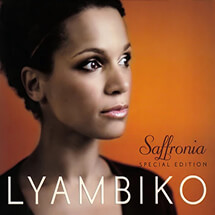
SAFFRONIA (2009)
Additions: Don't Explain; See Line Woman
- Black Is The Color / Break Down and Let It All Out
- Just Like A Woman
- Lilac Wine
- The Times They Are A-Changin
- Angel of the Morning
- Don’t Let Me Be Misunderstood
- Keeper Of The Flame
- To Love Somebody
- One Morning In May / The Pusher
- Ballad of Hollis Brown
- Feeling Good
- Barb Jungr – vocals, backing vocals, liner notes, producer
- Jenny Carr – musical director, piano, backing vocals
- Jessica Lauren – organ, harmonicas, mbira, autoharp, mellotron, electronic tanpura, backing vocals
- Johnny Lee – percussion, drums, clock sample
- Danny Thompson – bass
- Mark Lockheart – saxophones, clarinets
- Calum Malcolm – engineer, producer
- Steve Ullathorne – photography
Recording session: Livingston Studios – London – November 19-21, 2007
Catalog number: AKD 309
Liner notes:
Nina Simone embraced utterly Louis Armstrong’s understanding of music: “what we play is life” and “my whole life, my whole soul, my whole spirit is to blow that horn.” Nina sang and played with everything she had, and she took songs and inspiration from everything in her life and world. This was both her strength and her weakness, for that full commitment, that passion, is too strong a flavor for those faint of heart.
I grew up loving Nina Simone; that uncategorisable voice, her uncompromising approach to material, fearlessness in changing lyric and arrangement to make songs personal, and courageous musicianship. So when I heard her spirit speak demanding that I make a a collection dedicated to her, I complied without question. This is my ‘hymn to Nina’.
CD booklet:
- Do What You Gotta Do
- Don’t Let Me Be Misunderstood
- Ain’t Got No / I Got Life
- Mood Indigo
- Feeling Good
- Tomorrow Is My Turn
- I Loves You Porgy
- July Tree
- Love Me or Leave Me
- Ne Me Quitte Pas
- Sinnerman
- Wild Is The Wind
- Kellylee Evans – vocals
- Marvin Sewell – guitars
- Francois Moutin – acoustic bass
- André Ceccarelli – drums
- Pierre Bianchi – recording, mixing
- Raphael Jonin – mastering
- Matt Howe – photography
- Please Don’t Let Me Be Misunderstood
- Suzanne
- Real Real
- House of the Rising Sun
- Turn Me On
- Feeling Good
- Don’t Take All Night
- Nobody’s Fault But Mine
- Be My Husband
- Black Is The Color Of My True Love’s Hair
- See Line Woman
- Either Way I Lose
- To Be Young, Gifted, and Black
- Four Women
- Meshell Ndegeocello – vocals, guitar, producer
- Chris Bruce – guitar, producer
- Jebin Bruni – keyboards, piano
- Deantoni Parks – drums
- Toshi Reagon – vocals (tracks 3 & 4)
- Sinéad O’Connor – vocals (track 7)
- Lizz Wright – vocals (track 8)
- Valerie June – vocals (track 9)
- Tracy Wannomae – soprano saxophone, flute (tracks 11 & 13)
- Eric Elterman – engineer
- Pete Min – engineer, mixing, mastering
- Hilton Als – liner notes
- Charlie Gross – photography
For A Sovereign Soul – A Dedication To Nina Simone
Catalog number: NV827011
- I Put A Spell On You
- Little Girl Blue
- Don’t Explain
- Be My Husband
- Don’t Let Me Be Misunderstood
- My Man’s Gone Now
- Funkier Than A Mosquito’s Tweeter
- My Baby Just Cares For Me
- Tell Me More and More and Then Some
- Save Me
- Trouble In Mind
- Nobody Knows You When You’re Down and Out
- Morgan James – vocals, producer
- Doug Wamble – guitar
- Clarence Penn – drums
- David Finck – double bass
- David Cook – piano
- Ron Blake – saxophone
- Mary Ann Topper – producer
- Steve Tyrell – producer
- Rob Macomber – recording
- Jon Allen – engineering
- Bill Schnee – mixing
- Greg Calbi – mastering
- Maria Paula Marulanda – design
- JP Robinson – art direction
- Kat Hennessey – photography
- Kevin Thomas Garcia – photography
- Terry Teachout – liner notes
Recording session: Live at Dizzy’s Club Coca-Cola – New York City – July of 2012
Liner notes:
Imagine a voice big enough to knock you to the floor – and sensitive enough to make you shiver.
Imagine a singer with a perfect ear, an actor’s way with words, and a sense of time as sure as an atomic clock.
Here she is.
Morgan James has it all: soul, charm, chops, blue-chip musicianship, and the kind of absolute individuality that makes her singing as recognizable as a fingerprint. What’s more, she sounds as much at ease on the bandstand of a nightclub like Dizzy’s Club Coca-Cola as she does standing in a Broadway spotlight. I think she’s the most promising young vocalist to come along so far this century.
I first heard Morgan James in a performance of Guys and Dolls and went home asking myself, “Who is that?” Now I know. So will you.
CD booklet:
- My Baby Just Cares For Me
- Don’t Explain
- Baltimore
- Feeling Good
- Four Women
- I Love You Porgy
- If You Go Away
- I Put A Spell On You
- Keeper Of The Flame
- He Ain’t Comin’ Home No More
- Marriage Is For Old Folks
- Wild Is The Wind
- That’s All I Want From You
- Malia – vocals, producer
- Alexandre Saada – piano, organ, vibraphone, kalimba
- Jean-Daniel Botta – double bass, guitar
- Laurent Sériès – drums, percussion (kas kas)
- Adrien Hollocou – engineer
- Thomas De Fraguier – engineer
- Jean-Paul Gonnod – recording, mixing
- Goetz-Michael Rieth – mastering
- Daniel Yvinec – art direction
- Don’t Smoke In Bed
- Don’t Explain
- Wild Is The Wind
- Where Can I Go?
- See Line Woman
- Just Say I Love Him
- Four Women
- Pirate Jenny
- You’d Be So Nice
- The Other Woman
- Flo Me La
- Jamie Stewart – vocals, producer
- Tim Berne – alto saxophone, baritone saxophone
- Tony Malaby – tenor saxophone
- Mary Halvorson – guitar
- Andrea Parkins – accordion, piano, moog
- Ches Smith – drums, arrangement, producer
- Aaron Nevezie – recording
- Chris Koltay – mixing
- Collin Jordan – mastering
- Joe Stewart – design
- Black Swan
- Black Is The Color of My True Love’s Hair
- Little Girl Blue
- Fodder On My Wings
- Hey Buddy Bolden
- Images
- Brams – Bach: Schmücke dich, o liebe Seele, Op. 122 No. 5
- You Can Have Him
- I Wish I Knew How It Would Feel To Be Free
- That’s All I Want From You
- Brown Baby
- Stars
- Rachmaninoff: Sonata in G Minor, Op. 19 (Andante)
- Come Ye
- Return Home
- Sonia Weider-Atherton – cello
- Bruno Fontaine – piano
- Laurent Kraif – percussion
- Pierre-Antoine Signoret – mixing, mastering
- Theo Jegat – sound assistant
- Xavier Arias – photography
- Baltimore (Lianne La Havas)
- Sinnerman (Keziah Jones)
- Just Say I Love Him (Hindi Zahra)
- Black Is The Color Of My True Love’s Hair (Gregory Porter)
- My Baby Just Cares For Me (Olivia Ruiz)
- Feeling Good (Ben L’Oncle Soul)
- Four Women (Melody Gardot)
- Plain Gold Ring (Youn Sun Nah)
- I Put A Spell On You (Sophie Hunger)
- Lilac Wine (Camille)
Baltimore
- Lianne La Havas – vocals
- Bojan Z – piano
- Christophe Minck – bass, guitars
- Sébastien Martel – guitars
- Axel Le Guil – guitars
- Cyril Atef – percussion, drums
- Ensemble Archipel – strings orchestra
Sinnerman
- Keziah Jones – vocals, guitar
- Bojan Z – piano, backing vocals
- Christophe Minck – bass, n’goni, backing vocals
- Cyril Atef – percussion, drums, backing vocals
Just Say I Love Him
- Hindi Zahra – vocals
- Bojan Z – piano
- Clément Ducol – piano
- Christophe Minck – bass, additional keyboards
- Cyril Atef – percussion, drums
- Ensemble Archipel – strings orchestra
Black Is The Color of My True Love’s Hair
- Gregory Porter – vocals
- Melody Gardot – backing vocals
- Christophe Minck – harp
- Ensemble Archipel – strings orchestra
My Baby Just Cares For Me
- Olivia Ruiz – vocals
- Bojan Z – piano
- Christophe Minck – bass, guitars
- Cyril Atef – percussion, drums
- Brice Moscardini – trumpet
- Richard Blanchet – trumpet
- Sébastien Llado – trombone
- Cédric Ricard – saxophone
Feeling Good
- Ben L’Oncle Soul – vocals
- Bojan Z – piano
- Christophe Minck – bass
- Cyril Atef – percussion, drums
- Ensemble Archipel – strings orchestra
- Brice Moscardini – trumpet
- Richard Blanchet – trumpet
- Sébastien Llado – trombone
- Cédric Ricard – saxophone
Four Women
- Melody Gardot – vocals
- Clément Ducol – piano
- Christophe Minck – bass
- Cyril Atef – percussion, drums
Plain Gold Ring
- Youn Sun Nah – vocals, backing vocals
- Bojan Z – piano
- Christophe Minck – bass, additional keyboards
- Cyril Atef – percussion, drums
- Ensemble Archipel – strings orchestra
I Put A Spell On You
- Sophie Hunger – vocals
- Camille – backing vocals
- Bojan Z – piano
- Christophe Minck – bass, additional keyboards
- Cyril Atef – percussion, drums
- Ensemble Archipel – strings orchestra
Lilac Wine
- Camille – vocals
- Christophe Minck – harp
- Ensemble Archipel – strings orchestra
Strings
- Violin: Arnaud Chataigner (solo), JS Gonthier, Yanpeng Liu, Diem Truc Tran, JF Tixier, Yanpeng Liu, Daniel Macho, Guillaume Res, Rainer Halter, Tiphaine Hervouet, Nicolas Miller, Grace de Morgan, Alice Zimmerman, Miller Nicolas
- Alto: Lacombe Didier (solo), Dautry Emmanuelle, Elodie Robine, Marie-Pierre Jaques
- Cello: Pierre-François Dufour (solo), Agathe Leprince, Karine Delage, Andrei Jourdane
- Double Bass: Mathieu Sternat (solo), Julien Grostin (solo), Julia Robin
Technical
- Maxime Le Luil – recording, mixing, producer
- Clément Ducol – arrangement, orchestral direction, instrumental interludes, producer
- Aristide Rosier – assistant recorder, assistant mixer, digital editing, additional recording
- Brian Gardner – mastering
- Pierre-François Dufour – artistic direction
- Arnaud Chataigner – coordination
- François Gaucher – sound engineer
- David Brun-Lambert – liner notes
- Florence Larbey – design, painting
- Franco P Tettamanti – photography
- Jean-Baptiste Mondino – photography
Recording session: Studio PlusXXX – Paris, France; Lilac Wine recorded at Studio Alhambra Colbert – Rochefort, France; Black Is The Color recorded at Studio Gang – Paris, France; strings recorded at Studio Alhambra Colbert – Rochefort, France; Mixing at Studio PlusXXX – August 2014; Mastering at Bernie Grundman Mastering – Los Angeles, California – September 2014
Catalog number: 4706313
Liner notes:
Born Eunice Kathleen Waymon on February 21st, 1933 in Tryon, North Carolina, Nina Simone led several lives, drifting wherever she triumphed or foundered in her dreams of becoming Clara Haskil, Katherine Dunham, or an American Miriam Makeba, perhaps Maria Callas, too. While Nina lived, she never tasted the recognition that was offered to her models. Too wild. Bared. Unstable. Aggressive. Her violence (contained or not) was intimidating. She would go against the currents introduced or followed by her peers. In the end, her century unfairly turned its back on the woman who instigated a form of “Great Black American Music” that was her own, daring, synthesis of blues, soul, and classical music. Her most ample merits? They were only fully recognized after her passing, in the south of France in 2003. While she lived, there were so few to admit that the art of Nina Simone concerned principally hope, rather than tears or revolt; it was a universal grammar that would be her sole legacy, one for which her memory is still celebrated today, everywhere.
Long cherished intimately, the music of Nina Simone today constitutes a “world skin.” And so, ever since her passing, it’s influence can be read each season in the glowing tributes paid to her by the young guard of soul, rock, rap, or electro. This tribute album presents some of the latter. In rage or flayed alive, Sophie Hunter, Gregory Porter, Camille, or Melody Gardot are Nina’s children. As are her heirs Hindi Zahra, Ben l’Oncle Soul, Lianne La Havas, Youn Sun Nah, Olivia Ruiz, or Keziah Jones. In contributing to seed the art of Nina, these artists celebrate and popularize the remedial, mystical, sorcerers’ virtues of her music. They give to it a contemporary resonance whose impact always delights, often stuns, and at times intimidates, too.
A “world skin”, then. The term suits the music of a visionary the essential of whose work was recorded in scarcely more than one, brief decade. “Sinnerman” or “Four Women”, songs whose necessity is absolute; “I Put A Spell On You” or “Black Is The Color”: the inheritance of a Black child raised in the shadow of racism, and whose community ascribed her pianistic talents to “God’s will”; “Lilac Wine” or “Feeling Good”: the legacy of a frustrated classical concert-pianist/turned jazz-singer (by default) who, to thwart the anathema of her own holier-than-thou mother, one day invented a pseudonym for herself in a low dive in Atlantic City: “Nina Simone.” She was twenty-one. A destiny was calling…
Nina, for “girl child” in Spanish; Simone, for Signoret, whom she admired. An icon was soon to be born, doubling as a hit-parade idol and audacious performer. Then would come the enraged activist, committed body and soul to the struggle for Civil Rights as it gained in strength. And after that, the woman wrong, snapped, bruised, and frantic with love. It was still Nina. But this Nina had become a tragic figure, like Billie Holiday before her, another model of artistic commitment and human disaster. Ruined, disillusioned by the collapse of the ideals borne by the Movement, and finally abandoned by the record-industry, in the mid-Seventies Nina began roaming the Caribbean and from Africa to Europe. At the outcome of her curious odyssey–when she was ill in many respects–a mass audience rediscovered her in 1987 when a frivolous song she’d recorded three decades earlier resurfaced by chance: “My Baby Just Cares For Me”. But it was too late.
Diagnosed with bipolar disorder, obliged to make the most of the expectations aroused by her return to the limelight, Nina was then pushed onstage by an entourage whose principal motivation was gain. Enclosed in a heavy body that had become painful, the “Little Girl Blue” of before now offered only debacles to her public, not the concert of their hopes. And yet, on some nights, her taste for a fight reasserted itself. It was a matter of instinct. Her nature. And the public saw her disregard the bite of illness and sharply accelerate the tempo, her wildness rising at her discovery of unsuspected rapports or harmonic marches in a “Porgy” she had already played so often. Or, abruptly slowing the rhythm, pull harmonies to earth. Beneath her fingers, the least dissonance suddenly became a considerable event: each arpeggio mutated into a declaration of war and the slightest pause spoke of hope. Everything would again be wrapped in that “world skin”. The drifting performer was no more; no longer was there drama, even. An American genius was singing, of the bites of time, love, the suffering that lay in just being there, in living, in consuming herself. The world fell silent. Nina Simone was licking her wounds.
CD booklet:
- My Mama Could Sing [Intro] (Lisa Simone)
- Feeling Good (Ms. Lauryn Hill)
- I’ve Got Life (Ms. Lauryn Hill)
- Ne Me Quitte Pas (Ms. Lauryn Hill)
- Baltimore (Jazmine Sullivan)
- Love Me Or Leave Me (Grace)
- My Baby Just Cares For Me (Usher)
- Don’t Let Me Be Misunderstood (Mary J. Blige)
- Sinnerman (Gregory Porter)
- We Are Young, Gifted, and Black (Common & Lalah Hathaway)
- I Put A Spell On You (Alice Smith)
- I Want A Little Sugar In My Bowl (Lisa Simone)
- Black Is The Color Of My True Love’s Hair (Ms. Lauryn Hill)
- Wild Is The Wind (Ms. Lauryn Hill)
- African Mailman [Instrumental] (Ms. Lauryn Hill)
- I Wish I Knew How It Would Feel To Be Free (Nina Simone)
My Mama Could Sing (Intro)
- Lisa Simone – vocals
- Justin Tyson – drums
- Burniss Earl Travis – bass
- James Francies – keyboards
- Chris Sholar – guitar
Feeling Good
- Ms. Lauryn Hill – vocals
- Michel Ferre – piano, organ, synth, wurlitzer
- Jon Batiste – organ, synth, wurlitzer
- Max Drummey – additional keyboards
- Eric Gales – guitar
- Jordan Peters – guitar
- Leo Brooks – acoustic bass
- George “Spanky” McCurdy – live drums
I’ve Got Life
- Ms. Lauryn Hill – vocals
- Michel Ferre – piano, synth
- Max Drummey – synth
- Joe Harley – piano
- Eric Gales – guitar
- Sylvain Luc – guitar
- Darryl Jenifer – bass, guitar
- James “Biscuit” Rouse – live drums
Ne Me Quitte Pas
- Ms. Lauryn Hill – vocals, drum programming
- Michel Ferre – piano, synth
- Jon Batiste – organ, additional keyboards
- Max Drummey – synth
- Eric Gales – guitar
- Jordan Peters – guitar
- Leo Brooks – acoustic bass
- George “Spanky” McCurdy – live drums
Baltimore
- Jazmine Sullivan – vocals
- Marshall York – drums
- Al Carty – bass guitar
- James Francies – keyboards
- Corey King – horns
- Keyon Harrold – horns
- John Ellis – horns
- Margaux Whitney – viola
- Jasmin Charles – violin
Love Me Or Leave Me
- Grace – vocals, background vocals
- Justin Tyson – drums
- Burniss Earl Travis – bass
- James Francies – keyboards
- Chris Sholar – guitar
- Elena Pinderhughes – flute
- Ras Cassa Alexander – background vocals
My Baby Just Cares For Me
- Usher – vocals
- Salaam Remi – bass, drums, keyboards
- James Poyser – keyboards
- Vincent Henry – guitar
Don’t Let Me Be Misunderstood
- Mary J. Blige – vocals
- Justin Tyson – drums
- Vicente Archer – bass
- Robert Glasper – keyboards
- Chris Sholar – guitar
- Corey King – horns
- Keyon Harrold – horns
- J0hn Ellis – horns
Sinnerman
- Gregory Porter – vocals
- Justin Tyson – drums
- Burniss Earl Travis – bass
- James Francies – keyboards
- Chris Sholar – guitar
- Corey King – horns
- Keyon Harrold – horns
- John Ellis – horns
We Are Young, Gifted, and Black
- Common – vocals
- Lalah Hathaway – vocals
- Justin Tyson – drums
- Burniss Earl Travis – bass
- Robert Glasper – keyboards
- Chris Sholar – guitar
- Mamuna – background vocals
I Put A Spell On You
- Alice Smith – vocals
- Justin Tyson – drums
- Robert Glasper – keyboards
- Chris Sholar – guitar
I Want A Little Sugar In My Bowl
- Lisa Simone – vocals
- Justin Tyson – drums
- Burniss Earl Travis – bass
- James Francies – keyboards
- Chris Sholar – guitar
Black Is The Color Of My True Love’s Hair
- Ms Lauryn Hill – vocals, background vocals, drum programming
- Michel Ferre – piano, organ, synths
- Ray Angry – key bass, organ, synth
- Jon Batiste – organ, additional keyboards
- Eric Gales – guitar
- Jordan Peters – guitar
- Leo Brooks – acoustic bass
- George “Spanky” McCurdy – live drums, drum programming
Wild Is The Wind
- Ms. Lauryn Hill – vocals
- Michel Ferre – piano
- Leo Brooks – acoustic bass
African Mailman
- Michel Ferre – piano, organ, synth
- Eric Gales – guitar
- Jordan Peters – guitar
- Leo Brooks – acoustic bass
- George “Spanky” McCurdy – live drums
Technical
- Jayson Jackson – album producer, executive producer
- Suzette Williams – album producer, executive producer
- Peter Edge – album producer, executive producer
- Robert Glasper – producer
- Ms. Lauryn Hill – album producer, executive producer
- Dave Kutch – mastering
- Jeff Gilligan – art direction, design
- Fusako Chubachi – illustration
- Angela Davis – liner notes
Catalog number: 88875113622
Liner notes:
I first heard Nina Simone’s music as a high school student in the late 1950s in New York. Although her name did not yet by itself evoke black freedom, as when she later sang “All I want is equality / for my sister, my brother, and me,” I do not think that I was alone in feeling that something in her phenomenal voice beckoned us toward the battle to come. As we moved into the 1960s and an increasing number of people identified with the call to bring down segregation in the South, Nina Simone’s music helped us to navigate the contradictions that propelled the black struggle forward. It was from Nina Simone that we learned, for example, how not to interpret the tactical importance of nonviolence as mitigation of our collective anger against racism. Thus, “Mississippi Goddam” became as important and anthem of the Civil Rights Movement as “We Shall Overcome”.
For those of us who were fortunate to follow her from the earliest stages of her career, the music she forged with her haunting voice and her multi-genre instrumental forays helped to guide us through the complex turns of the black freedom movement. In this sense, her music was always more than a soundtrack of the movement. It was much more foreground than background. It was not mere accompaniment. It announced, asserted, and innovatively played the changes of the movement.
As a young activist, one of my favorite songs was her cover of Lotte Lenya’s “Pirate Jenny” from Berthold Brecht’s and Kert Weil’s “Threepenny Opera”. I do not think I fully understood then why it spoke to me so powerfully — although the intensity of her recorded performance is by itself a sufficient explanation. Later I came to realize that while virtually all of the dominant voices of resistance were male, here was a black woman musician redefining the content of this song to depict the collective of black women domestic workers. Nina Simone compelled us to think about those primary agents of change, relegated to invisibility but without whom the Montgomery Bus Boycott would not have been able to launch the 20th Centre freedom movement. In this sense, she helped to introduce gender into our ways of imagining radical change long before it became a permanent category in our political vocabulary.
In 1968, as a member of the newly formed Los Angeles SNCC, I was one of the organizers of a massive birthday celebration at the LA Sports Arena for the imprisoned Huey P. Newton. During this Free Huey extravaganza, a merger (short-lived as it would turn out to be) was announced between the Black Panther Party and the Student Non-Violent Coordinating Committee. Speakers ranged from H Rap Brown (Jamil Abdullah Al-Amin), Stokely Carmichael (Kwame Toure) and James Foreman to Bobby Seale, Corky Gonzalez, and Reies Tijerina. As I recall, not a single woman was invited to speak. However, Nina Simone was asked to perform. While I felt deeply privileged to be present at that event, at which so many of the movement’s major players were present, it was Nina Simone’s voice that bestowed on that gathering an aura of historical transcendence. In representing all of the women who had been silenced, in sharing her incomparable artistic genius, she was the embodiment of the revolutionary democracy we had not yet learned how to imagine. At that moment we were no longer powerless individuals but rather a formidable collective force that was moving irreversibly in the direction of radical change.
For almost as long as I can remember, Nina Simone’s music has guided us, strengthened us, and bolstered the creation of communities of resistance. While many artists have enthusiastically supported the quest for a social justice, few have been so relentless in their efforts to dedicate their careers to the goal of collective political transformation. I followed Nina Simone as she made the transition from movements demanding the acknowledgement of our rights as citizens to insurgent movements calling for the economic and political restructuring of our society. With her, I moved from an assimilationist project to a revolutionary project. I also learned from Nina Simone that our capacity to embrace the large causes is only valuable to the extent that we are able to apprehend and embrace equality and justice on more intimate levels as well. I thus found guidance not only in “Mississippi Goddam,” “Pirate Jenny,” “Old Jim Crow,” “Four Women,” “Young Gifted and Black, and “I Wish I Knew How It Would Feel To Be Free,” but also in “I Put A Spell On You,” “I Want A Little Sugar In My Bowl,” “Don’t Let Me Be Misunderstood,” and “Ne Me Quitte Pas.”
In 1971 I was deeply moved when I was informed that Nina Simone wanted to visit me in jail. When she did not appear at the appointed time, I worried that the visit had been called off. But as it turns out, the occasion for delay was the jail authorities’ refusal to allow her to bring into the secured area the gift she wanted to present to me. When she finally appeared, she was holding a beautiful red helium-filled balloon. I learned that she had engaged in an extended verbal battle with the guards, whose evocation of the rules was no match for Nina Simone’s tenacity. Over the next period, as it gradually lost it buoyancy, this balloon remained one of the few permanent fixtures in my cell. Even when it was entirely deflated, I preserved it as a treasured artifact of my time with the amazing Nina Simone.
I now discover that this story of the balloon has acquired a second, more public life, in that it inspired the artwork for “Nina Revisited: A Tribute To Nina Simone.” The artists who pay tribute to her on this extraordinary album range from Ms. Lauryn Hill, Common, Lalah Hathaway, and Mary J Blige to Lisa Simone, Usher, Gregory Porter, Grace, and Alice Smith. Jazmine Sullivan sings “Baltimore,” the song that powerfully accentuates the contemporary reach of Nina Simone’s music. “Hard Times in the city / In a hard town by the sea / Ain’t nowhere to run to / There ain’t nothing here for free.” As this album is released, the case of Freddie Gray, the young black man who died in the custody of the Baltimore Police Department, has emerged as the most recent symbol of racist state violence, against which young activists are passionately mobilizing under the slogan “Black Lives Matter.”
Just as Nina Simone’s music inspired and guided those of us who struggled to defeat previous manifestations of racism, today it bridges the collective imagination of fifty years ago and the spectacular, awakening consciousness of a younger generation today. It is fitting that the last track on the album is Nina herself: “I Wish I Knew How It Would Feel To Be Free.”
Print ad:
CD booklet:
- Nina Cried Power (feat. Mavis Staples)
- NFWMB
- Moment’s Silence (Common Tongue)
- Shrike
- Andrew Hozier-Byrne – vocals, guitar, piano, synth, handclaps, percussion, bells
- Lorraine Cato – backing vocals
- Priscilla Jones-Campbell – backing vocals
- Alex Ryan – bass, piano, handclaps, percussion
- Rory Doyle – drums, handclaps, percussion
- Mavis Staples – vocals
- Booker T. Jones – organ
- Paul Clarvis – shaker, tambourine
- Markus Dravs – mono synth, bass synth, handclaps, finger snaps
- Iain Berryman – finger snaps, recording
- Sarah Lynch – violin
- Ben Tolliday – engineer
- Robbie Nelson – engineer
- Nathaniel Graham – engineer
- Greg Calbi – mastering
- Andrew Scheps – mixing
- Mike Crossey – mixing
- Jim Carrol – recording
- Rachel Blum – recording
- Lucy Nuzum – photography
- Raine Hozier-Byrne – art direction
- Jon Jozier-Byrne – artwork production
- Feeling Good
- Ready or Not feat. The Fugees
- Doo Wop (That Thing)
- To Zion feat. Carlos Santana
- Fu-Gee-La feat. The Fugees
- The Sweetest Thing feat John Forte
- Take It Easy
- Peace of Mind
- Lost Ones
- Killing Me Softly
- If I Ruled The World feat. Nas
- How Many Mics feat. The Fugees
- So High feat. John Legend
- Care For What
- Angel of the Morning
- The Miseducation of Eunice Waymon
- Fu-Gee-La (Refugee Camp Remix)
- Amerigo Gazaway – producer
- Rickey Mindlin – executive producer
- Feeling Good
- My Baby Just Cares For Me
- Ne Me Quitte Pas
- Wild Is The Wind
- Work Song
- Four Women
- I’m Going Back Home
- Ledisi – vocals, producer
- Lizz Wright – vocals
- Alice Smith – vocals
- Lisa Fischer – vocals
- Jules Buckley – conductor (Metropole Orkest), producer
- Adonis Rose – conductor (New Orleans Jazz Orchestra), producer
- Rex Rideout – executive producer
- Gregg Field – mixing, producer
- Reuben Cohen – mastering
Recording session: Tracks 1, 2, 3, 5, 6 (Ledisi & Alice Smith vocals only), 7 – Stagg Street Studio – Van Nuys, California – November 2020; Track 6 (Lizz Wright vocals) – Lynne Earls – Los Angeles, California – November 2020; Track 6 (Lisa Fischer vocals) – Elph-ish – New York City – November 2020
Catalog number: 538695082
